

Flipkart Case Study: The Rise Of Indian E-commerce Giant
Supti Nandi
Updated on: April 8, 2024
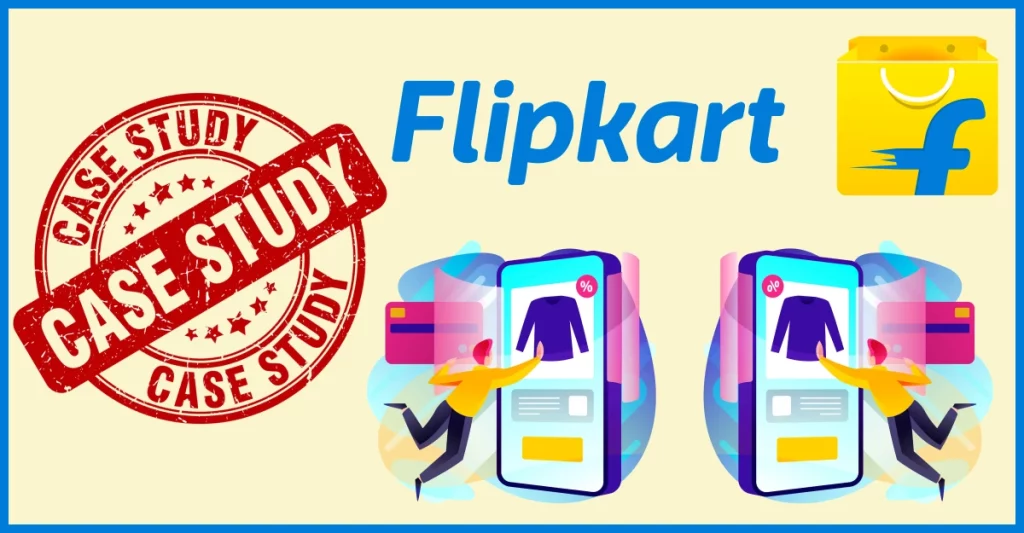
When it comes to success stories, the Flipkart Case Study has been the most anticipated one! Reason? A company from its humble beginnings rose to fame so immensely that now it has become synonymous with online shopping. Just like Google is synonymous with search engines and Paytm is synonymous with online payment in India!
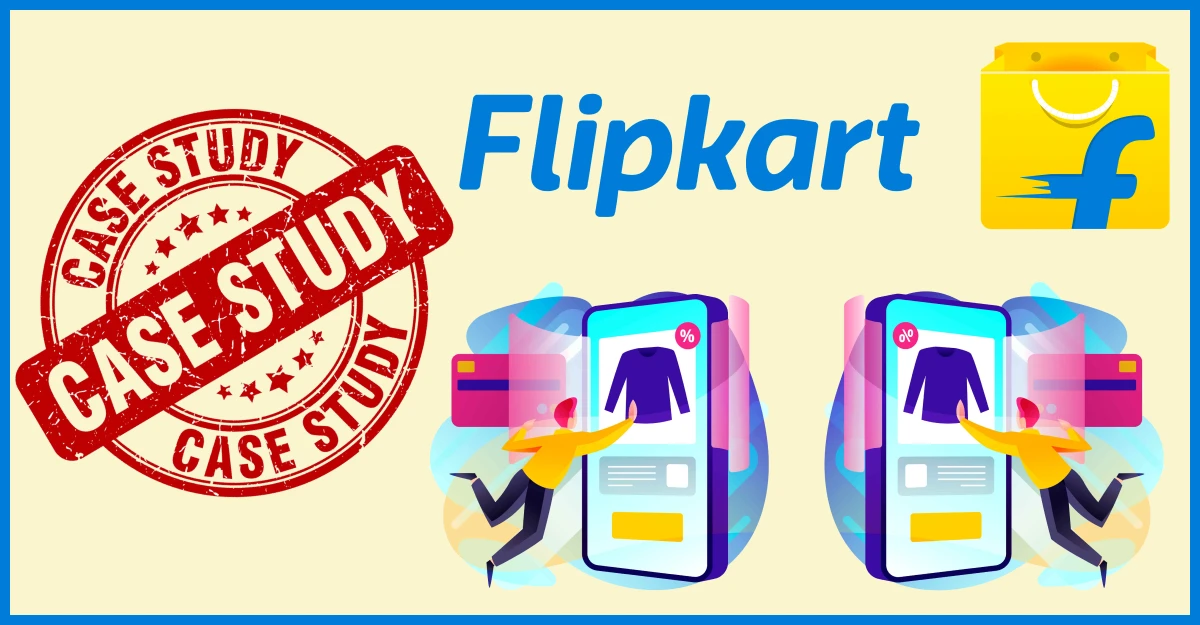
Let me tell you that when a brand becomes synonymous with a process, then that’s solid evidence of success.
Coming back to the point, Flipkart, the Indian e-commerce giant changed how you shop online. From its start, facing challenges, to becoming a big player in online retail, Flipkart’s journey is fascinating.
In this Flipkart Case Study, we will look at its early days, growth strategies, and the impact it had on how Indians shop. Also, its key moments include its joining forces with Walmart and still, it continues to evolve.
So, without any delay, let’s go through the Flipkart Case Study to understand Flipkart’s rise and how it shaped the e-commerce landscape in India.
(A) What is Flipkart? A Brief Overview
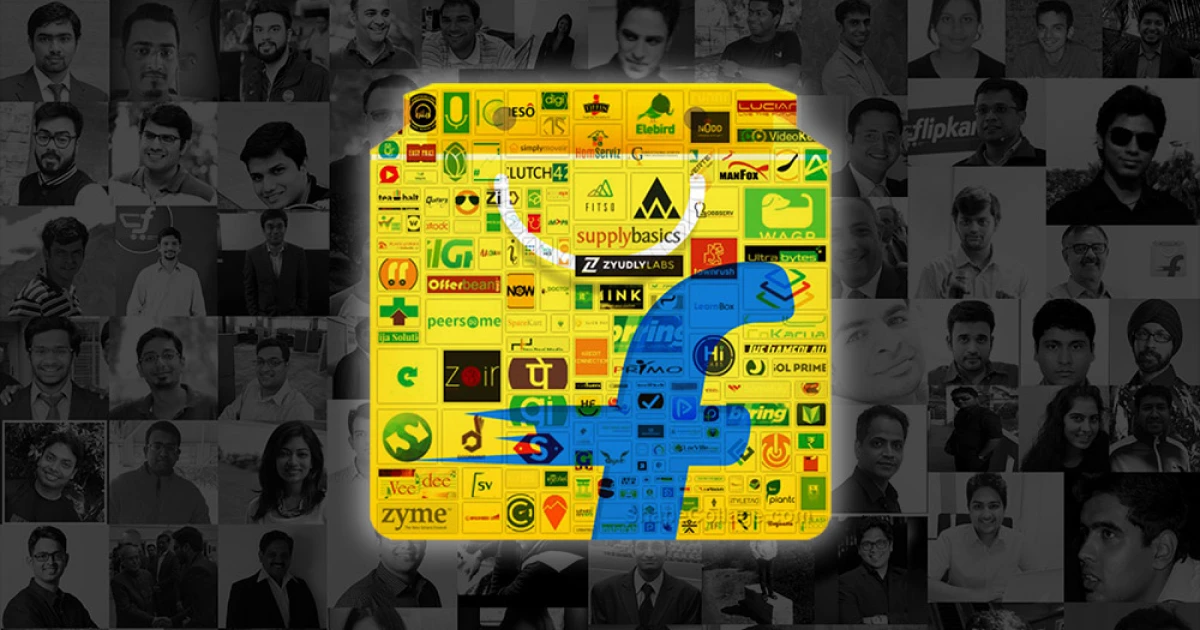
Flipkart Private Limited, an Indian multinational e-commerce giant, has its headquarters in Bangalore and is incorporated as a private limited company in Singapore. The company’s journey began with a primary focus on online book sales. However, as it evolved, Flipkart expanded its product range to include diverse categories such as consumer electronics, fashion, home essentials, groceries, and lifestyle products.
In the competitive landscape of the Indian e-commerce industry, Flipkart is a key player, directly competing with major entities like Amazon India and local rival Snapdeal.
Note: We have already explained “ Why did Snapdeal fail? Complete Snapdeal Case Study ” in detail. Check out the article for depth information.
As of March 2023, Flipkart held a significant market share, boasting 51% dominance in the country’s e-commerce sector.
One notable aspect contributing to Flipkart’s success is its strategic acquisition of Myntra, which has solidified its position in the apparel segment. This move has been pivotal in establishing Flipkart as a dominant force in the online fashion market.
Moreover, Flipkart has successfully positioned itself as a strong contender against Amazon in the sale of electronics and mobile phones, showcasing its versatility and adaptability in catering to diverse consumer needs.
We will explain it in more detail in the upcoming sections.
For now, let’s have a look at Flipkart’s profile-
| Private & Subsidiary | |
| Walmart | |
| E-Commerce | |
| 2007 | |
| Sachin Bansal,Binny Bansal | |
| Bangalore (Karnataka, India- Operational HQ) Singapore(Legal Domicile) | |
| India | |
| Online Shopping | |
| $37.6 billion | |
| $7.7 billion | |
| ANS Commerce, Cleartrip, Ekart, Flipkart Health+, Flipkart Wholesale, Jeeves-F1, Myntra, Shopsy, Yaantra | |
| Amazon, Ajio, Alibaba, Snapdeal, Shopclues, Myntra, ETSY, etc. |
In essence, Flipkart’s trajectory from an online book retailer to a multifaceted e-commerce giant is marked by strategic expansions, key acquisitions, and robust competition in the dynamic Indian market.
(B) History of Flipkart
Flipkart’s foundation in India was laid in October 2007 by Sachin Bansal and Binny Bansal, both alumni of IIT Delhi and former employees of Amazon. The duo initiated their venture from a modest two-bedroom apartment in Koramangala, Bangalore.
Fueled by their vision to revolutionize online retail, the initial investment of INR 2 lakh from each founder’s family set the stage for what would become a transformative journey.
Starting as an online bookstore with a nationwide shipping approach, Flipkart strategically focused on the sale of books. The company gradually gained prominence, processing 100 orders per day by 2008. This early success laid the groundwork for Flipkart’s expansion beyond books into diverse product categories.
Now, let’s briefly look at the history of Flipkart-
| Founded in Bangalore by Sachin and Binny Bansal, focusing on online book sales. | |
| Acquired We Read and expanded offerings to country-wide book sales. | |
| Acquired Letsbuy, entering the electronics retail sector. | |
| Acquired Myntra for US$280 million, reprised Big Billion Days event with significant success. | |
| Acquired Appiterate, MapmyIndia, and PhonePe. | |
| Acquired Jabong.com and invested in TinyStep. | |
| Acquired eBay.in and made an unsuccessful offer to acquire Snapdeal. | |
| Walmart acquired a 77% controlling stake in Flipkart for US$16 billion. | |
| Invested US$4 million in EasyRewardz. | |
| Launched Flipkart Wholesale, acquired a stake in Arvind Youth Brands, and introduced Flipkart Quick. | |
| Acquired Cleartrip and ventured into the hotel industry. | |
| Launched the Flipkart Foundation, entered NFT and Web3 segment, and created Flipverse. | |
| Introduced ‘Flipkart Student’s Club’ and ‘Flipkart Green’. | |
| Binny Bansal resigned, selling his stake to Walmart. |
The journey from a small startup to an e-commerce giant included significant milestones such as the acquisition of We Read in 2010, further diversifying Flipkart’s offerings. This period marked the foundation of Flipkart’s presence in the Indian market, and its commitment to customer satisfaction and innovation paved the way for its subsequent growth, mergers, and acquisitions in the years to come.
(C) Growth Strategies: How did Flipkart rise in the Indian e-commerce market?
Flipkart rose in the Indian market by opting for numerous effective strategies. Go through the following table and you will get to know it-
| Flipkart prioritized customer satisfaction by offering competitive prices, a user-friendly interface, and reliable delivery. | ||
| Their “Cash on Delivery” option addressed trust issues in the Indian market. | ||
| Flipkart pioneered the concept of annual sales events like “Big Billion Days,” offering massive discounts and attracting millions of shoppers. | ||
| Recognizing the surge in mobile internet usage, Flipkart optimized its platform for mobile devices. | ||
| Flipkart invested heavily in building a robust logistics network, ensuring timely deliveries across India. | ||
| Their “Flipkart Assured” program guarantees quality products and faster shipping. | ||
| Flipkart transitioned from an inventory-based model to a marketplace, allowing third-party sellers to list their products. | ||
| This expanded their product catalog without the need for massive inventory investments. | ||
| Flipkart acquired companies like Myntra, Jabong, and PhonePe, strengthening its position in fashion and digital payments. | ||
| Partnerships with smartphone brands for exclusive launches boosted their visibility. | ||
| Flipkart secured significant funding from investors like Tiger Global, SoftBank, and Microsoft. These investments fueled growth and allowed them to compete with global players like Amazon. | ||
| Flipkart embraced new technologies, including AI-driven recommendations and personalized experiences. They expanded into grocery delivery, recognizing the potential in this segment. | ||
| Flipkart faced challenges related to competition from Amazon, changing regulations, and allegations of unfair practices. | ||
| The government scrutinized their business model and marketplace policies. | ||
| In 2018, Walmart acquired a majority stake in Flipkart for $16 billion. This deal provided Flipkart with additional resources and global expertise. |
Imagine a journey that begins with a small team, determined to redefine how people shop online. That’s the story of Flipkart, and it’s a tale filled with strategic moves and innovative thinking.
From the outset, customer satisfaction was at the forefront of Flipkart’s strategy. They understood the importance of competitive pricing, a user-friendly interface, and reliable delivery to win over the hearts of Indian shoppers. Introducing the “Cash on Delivery” option addressed trust concerns in a market where online payments were met with skepticism.
But Flipkart didn’t stop there.
They introduced groundbreaking events like “Big Billion Days,” turning ordinary shopping into a festival of massive discounts. Recognizing the shift towards mobile internet usage, they optimized their platform for mobile devices, making shopping accessible to millions on the go.
Building a robust logistics network became a cornerstone for Flipkart. Timely delivery, coupled with innovative programs like “Flipkart Assured,” ensured quality products reached customers swiftly. The transition from an inventory-based model to a marketplace allowed third-party sellers to join in, expanding Flipkart’s product catalog without huge inventory investments.
Strategic acquisitions, including Myntra, Jabong, and PhonePe, strengthened their position in fashion and digital payments. Partnerships for exclusive smartphone launches boosted their visibility while securing funding from investors like Tiger Global and SoftBank fueled their growth, enabling them to compete globally.
However, every story has its challenges. Flipkart faced setbacks from competition, changing regulations, and allegations of unfair practices. Regulatory scrutiny became a part of their narrative as the government examined their business model.
In a pivotal moment, Walmart stepped into the story, acquiring a majority stake in Flipkart for $16 billion in 2018. This move not only injected additional resources but also brought global expertise to Flipkart’s journey.
From adapting to changing trends, embracing new technologies, and facing challenges head-on, to the transformative Walmart acquisition – Flipkart’s story is a testament to resilience, innovation, and the pursuit of customer satisfaction in the ever-evolving landscape of e-commerce.
(D) Impact of Flipkart on Indian Retail: How has it disrupted the traditional retail models?
Flipkart has significantly disrupted traditional retail models in India, reshaping the landscape and transforming how consumers shop. You have witnessed it too! Let’s look at the impact of Flipkart on the retail landscape of India-
| Flipkart’s online platform provides consumers with the convenience of shopping at any time from the comfort of their homes, breaking away from the constraints of traditional store hours. | ||
| It has expanded access to products for consumers in remote areas, overcoming geographical limitations associated with brick-and-mortar stores. | ||
| Flipkart’s vast product catalog spans various categories, offering consumers a diverse range of choices beyond what traditional stores might carry. | ||
| Flipkart’s pioneering concept of events like “Big Billion Days” disrupted the traditional sales model, attracting millions with massive discounts and exclusive deals. | ||
| Online platforms like Flipkart promote price transparency, allowing consumers to easily compare prices and make informed purchasing decisions. | ||
| Flipkart’s user-friendly interface and innovative features enhance the overall shopping experience, introducing elements like personalized recommendations and reviews. | ||
| Recognizing the surge in mobile internet usage, Flipkart optimized its platform for mobile devices, making shopping accessible to a broader audience. | ||
| Heavy investment in logistics ensures timely deliveries across India, addressing one of the common challenges faced by traditional retailers. | ||
| Initiatives like “Flipkart Assured” guarantee quality products and faster shipping, enhancing customer trust. | ||
| Flipkart’s shift from an inventory-based model to a marketplace allows third-party sellers to list their products. This increases the product range without the need for massive inventory investments. | ||
| The acquisition of PhonePe enhanced Flipkart’s presence in digital payments, promoting a seamless and cashless transaction experience for customers. | ||
| Flipkart has adapted to emerging trends, exploring new technologies, expanding into grocery delivery, and entering the NFT and metaverse space in response to evolving consumer preferences. |
The Confederation of All India Traders (CAIT) contends that Flipkart’s practices have adversely affected small retailers. Many traditional retail businesses have struggled to compete, resulting in job losses and a decline in the sector.
The Competition Commission of India (CCI) is currently investigating the allegations against Flipkart. If found guilty, fines or changes in business practices may be imposed. The government is also considering new regulations to promote fair competition in the e-commerce sector.
(E) Business Review: How Flipkart is Performing Businesswise?
Why do we always analyze the companies from a business perspective? You may wonder! Well, this is a crucial aspect of the case studies. It immensely helps investors, stakeholders, and decision-makers.
Looking at Flipkart’s conditions from a business perspective offers insights into its strategies, financial stability, market presence, and customer service approaches.
So, let’s look at the business aspects of Flipkart-
| $37.6 billion (market Valuation) | |
| 51% | |
| Walmart (80.5%) Tencent (5.3%) Tiger Global (4.1%) Binny Bansal (2.4%) CPPIB (2.2%) SoftBank Group (1.4%) QIA (1.3%) Microsoft (1.2%) Accel (1.1%) Others (0.5%) | |
| Rs.51,176 crore (FY22) Rs.56,013 crore (FY23) | |
| Rs.54,580 crore (FY22) Rs.60,858.5 crore (FY23) | |
| Rs.3,371.2 crore (FY22) Rs.4,890.6 crore (FY23) |
From the table, it’s evident that Flipkart holds a substantial market valuation of $37.6 billion, boasting a dominant 51% market share in India. The major shareholder is Walmart, holding an 80.5% stake.
Despite a significant revenue increase from Rs.51,176 crore (FY22) to Rs.56,013 crore (FY23), expenses also escalated from Rs.54,580 crore to Rs.60,858.5 crore.
The company reported losses of Rs.3,371.2 crore (FY22) and Rs.4,890.6 crore (FY23). This data provides a snapshot of Flipkart’s financial landscape, showcasing its valuation, market share, shareholder structure, revenue, expenses, and losses in the specified fiscal years.
(F) Competitive Landscape of Flipkart
Flipkart operates in a highly competitive e-commerce landscape in India facing fierce competition from various players. The key rivals include-
- Amazon India: One of the major competitors, Amazon has a substantial presence in India, offering a diverse range of products and services. The battle for market share between Flipkart and Amazon is a defining aspect of the e-commerce landscape. We have thoroughly explained Amazon vs Flipkart . You can check that article for detailed information.
- Snapdeal: Though not as dominant as Flipkart and Amazon, Snapdeal remains a significant player, especially in certain product categories. The competition with Snapdeal adds to the dynamic nature of the market.
- New Entrants: The e-commerce sector in India has witnessed the entry of new players, both domestic and international, intensifying the rivalry and driving innovation in the industry.
Every year, Flipkart hosts a huge event called the “Big Billion Days” where they offer big discounts and special deals to attract lots of shoppers.
Flipkart’s focus is on making customers happy. They keep prices low, make the website easy to use, and deliver orders reliably.
One smart move they made was changing how they sell things – instead of owning all the products, they let other sellers join their platform, giving customers more choices without needing a huge warehouse.
Along the way, Flipkart made important friends by acquiring companies like Myntra, Jabong, and PhonePe. These additions helped Flipkart become better in fashion and digital payments.
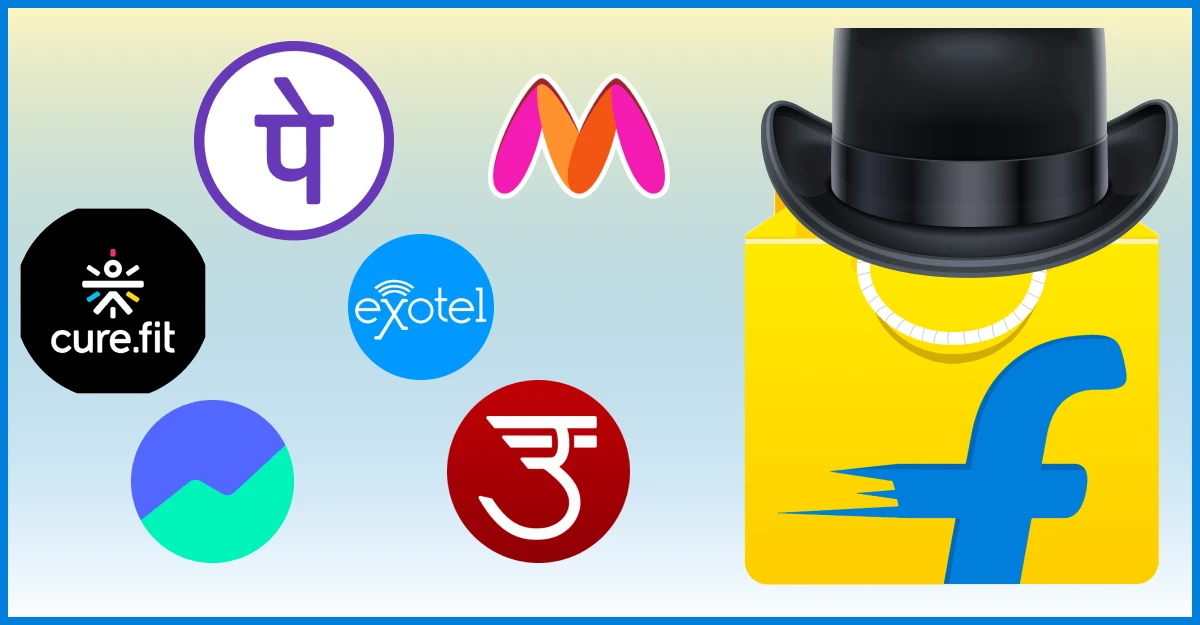
To keep up in this fast-changing world, Flipkart also uses technology well, especially on mobile phones. They invest a lot in making sure orders reach customers on time. Despite facing challenges,
Flipkart’s story shows how they adapt and compete, making them a big player in India’s online shopping tale!
(G) Challenges Faced by Flipkart
Here are some of the tough challenges that Flipkart faced while commencing its operations in India-
| E-commerce in India operates in a low ticket price market. Logistics costs pose a significant challenge for Flipkart. Lowering logistics costs is crucial for further increasing e-commerce penetration. | |
| Amazon, another major player in Indian e-commerce, competes fiercely with Flipkart. Both companies vie for market share and customer loyalty. | |
| Flipkart has faced allegations related to exclusive launch agreements, fake sellers, and market dominance. The Competition Commission of India (CCI) is investigating these practices. | |
| Keeping up with technological advancements and consumer preferences is essential. Flipkart must innovate to stay relevant. | |
| While growth is crucial, achieving profitability remains a challenge. Balancing investments, discounts, and operational costs is a delicate task. |
These challenges reflect the dynamic nature of the e-commerce industry and the need for strategic agility by Flipkart.
(H) Post-Acquisition Developments of Flipkart
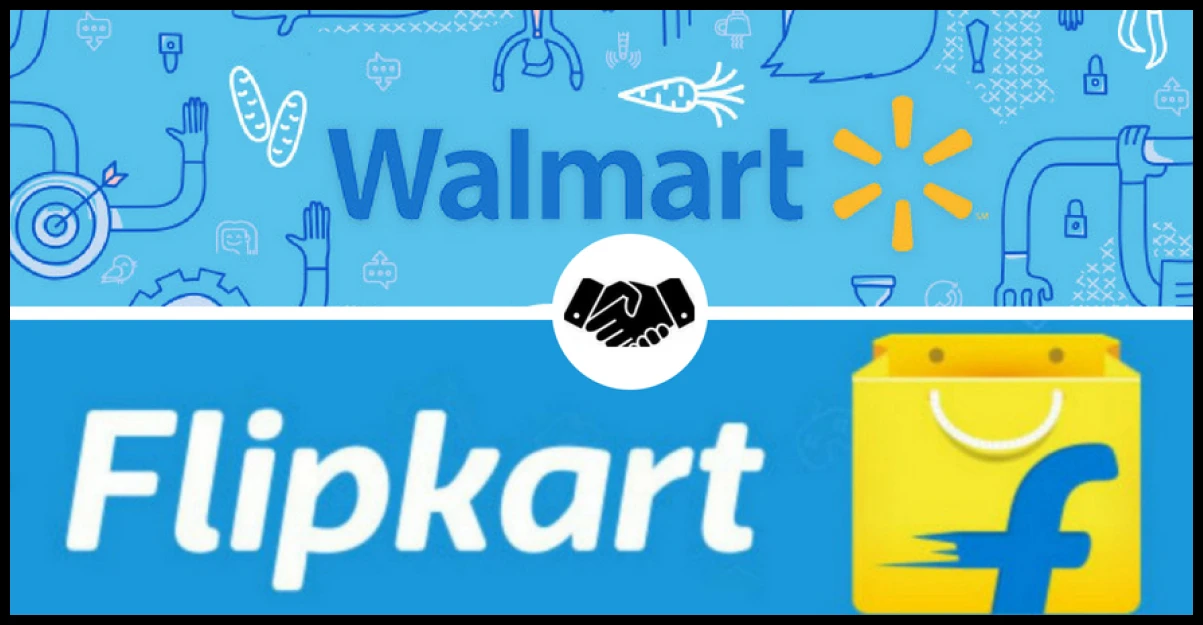
Let’s go through the post-acquisition developments of Flipkart following Walmart’s acquisition-
| In 2018, Walmart acquired a 77% stake in Flipkart for approximately $16 billion. This deal valued the 11-year-old Indian e-commerce firm at $20.8 billion. | |
| The acquisition provided SoftBank Vision Fund with a profitable exit, as they had previously invested heavily in Flipkart. Tiger Global, another major investor, also benefited significantly from the deal. Flipkart’s Indian founders and employees secured a smaller share of the valuation around 10%. | |
| Flipkart announced plans to transition its delivery fleet to electric vehicles by 2030. This move aligns with sustainability goals and contributes to reducing the company’s environmental impact. | |
| Despite challenges, including the cost structure of logistics, Flipkart remains a dominant player in the Indian e-commerce market. The company posted a 9.4% increase in consolidated net total income for FY23. However, its losses widened due to investments and operational costs. | |
| In July 2021, Flipkart achieved the milestone of 100% elimination of single-use plastic packaging throughout its supply chain ecosystem. The company continues to focus on innovation and sustainable practices. |
Thus, Walmart’s acquisition of Flipkart brought both opportunities and challenges. Simultaneously, it immensely helped in shaping the e-commerce ecosystem in India and impacted millions of consumers.
(I) Wrapping Up the Flipkart Case Study
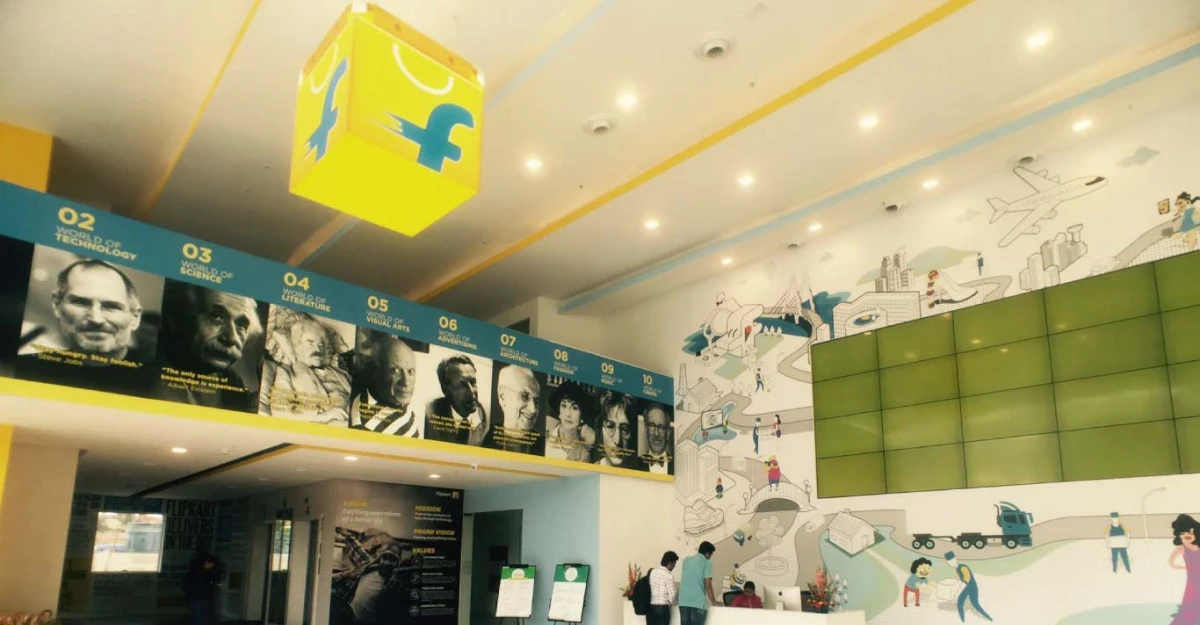
In a nutshell, Flipkart’s journey from a small startup in 2007 to an Indian e-commerce giant is marked by strategic innovation, customer-centricity, and adaptability. Pioneering events like “Big Billion Days,” embracing a marketplace model, and strategic acquisitions have been pivotal.
The company’s commitment to customer satisfaction, technological integration, and expansion into diverse segments showcase its resilience . The acquisition by Walmart in 2018 added global expertise, propelling Flipkart to a $37.6 billion valuation.
As it ventures into new territories, Flipkart’s story remains a testament to its impact on India’s retail landscape and its ability to evolve with changing times!
Related Posts:
Contact Info: Axponent Media Pvt Ltd, 706-707 , 7th Floor Tower A , Iris Tech Park, Sector 48, Sohna Road, Gurugram, India, Pin - 122018
© The Business Rule 2024
Now, Flipkart functions entirely in India, with headquarters in Bangalore, Karnataka and earning 4500 crores annually. In no time, Flipkart also started offering other products like electronic goods, stationery supplies, fashion, home essentials and groceries.
The company now gives employment to around 5000 people. It has a consumer base of approximately 2 billion people and the company claims to deliver more than thirty thousand parcels per day.
Currently, Flipkart stores its products in its warehouses across the country. They have a delivery network across 27 cities. It helps the company to deliver orders to their customer within an appropriate time.
With passing time, internet penetration has grown across the world, hence it also acts as a booster for e-commerce platforms as it provides a secure payment option to customers.
What led to the growth of Flipkart was increasing internet connectivity in rural and urban areas.
Availability of a wide range of products from anywhere and that too at the customer’s doorstep with feasible and affordable prices.
Equipped work schedules of the young population led to more online and indoor shopping which eventually helped Flipkart grow at a faster pace.
Though, Flipkart currently faces tough competition from Amazon, what remains is the main objective is to create a unique image in the consumer’s mind.
After having an idea about the company’s evolution and how it created its own space in the Indian e-commerce markets, let’s dive deep into what are the marketing strategies that Flipkart adopted.

Marketing strategies of Flipkart
1 . product:.

The company generally offers its customers with wide range of products. It deals in almost all segments except for automobiles. Flipkart has recently started a grocery store to increase its market share.
The major reason Flipkart for being the most used app for online shopping is that the app is user-friendly which gives the user a phenomenal experience while browsing.
2. Pricing:

The company provides several filters for the products as per the price range selected by the customer, and easy payment options. Flipkart was the first company to provide. cash on delivery option to its users in the year 2010. The products are delivered on time and are of good quality since they are packed with utmost care to avoid any sort of damage.
The 15-day exchange policy of the company gains consumers’ confidence in buying products. Recently launched pay later option with a minor convenience fee, helps the customer to easily convert their buying into EMIs. The company also offers exclusive discounts and price drops on the occasion of Indian festivals and sales.
3. Promotion:

Flipkart can target every age group of audience irrespective of what product they are looking for online. The smart marketing strategy of Flipkart grabs the attention of its viewers who hold the power to buy and are aware that online shopping is better than offline shopping since it provides them with much better options to explore than any retailer would ever give them.
You must have heard about the term SEO; it stands for search engine optimisation.
Now what exactly is SEO It is a set of strategies and practices used to improve a website’s visibility in search engine results pages like Google, Bing, and Yahoo. The primary goal of SEO is to increase non-paid traffic to a website and boost its overall online presence.
As per the latest findings, Flipkart tops the online search results with a total of 55.6 million searches, out of which 11.3 million were mobile searches and 44.3 million were desktop searches. Also, when it comes to SEO, the loading speed of the site plays an important part since it will decide if the users will visit your site or not. Flipkart does this job great. It just takes 2 seconds for the site to load the content for its consumers.
To promote the app Flipkart has also collaborated with various Indian celebs who act as influencers for people who search for online products.
4. Advertising campaigns launched by Flipkart

One of Flipkart’s most significant annual sales events is the “Big Billion Days.” Flipkart runs wide-ranging marketing campaigns, offering discounts and deals across various product categories. These campaigns feature engaging advertisements to build eagerness and attract customers.
Flipkart ran an advertising campaign centred around our toddlers and teenagers —a voice search for kids. The campaign showcased how kids could use their voices to search for toys and other products on the app, making it easier for parents to shop for their children.
Flipkart often runs campaigns emphasizing mobile phone exchange offers, encouraging customers to upgrade their phones by exchanging their old ones. These campaigns ensure that consumers should get cost-efficient and best deals.
Flipkart introduced “Flipkart Plus,” a loyalty program offering benefits such as free and faster delivery, early access to sales, and reward points for regular customers.
Flipkart’s marketing team has a great quality of analysing consumer behaviour and based on this, they started a sort of advertising campaign which you guys must have seen while scrolling through the app, “Frequently Bought Together”. In this Flipkart suggests the buyer the product which is frequently bought by the audience.
There are various other marketing strategies that Flipkar̥t tries to implement to promote the app globally.
By now our readers must have got an idea why Flipkart holds an essential place in the market and gives tough competition to Amazon.
Flipkart’s business model depends on simplifying transactions between buyers and sellers, charging fees for various services, and constantly inventing to improve the customer experience and seller support.
Flipkart operates as a recognized e-commerce platform in India with a business model that revolves around being an online marketplace. It connects a wide range of sellers with consumers, offering diverse products and services. Flipkart’s marketing strategy is essential in establishing its brand, attracting customers, and maintaining a competitive edge in the e-commerce industry.
Divulge the amazing story of Coca-Cola .
FAQs (Frequently Asked Questions)
- When was Flipkart founded? Flipkart was founded in the year 2007.
- Who founded Flipkart? Sachin Bansal & Binny Bansal founded Flipkart.
- Is Flipkart an Indian company? Yes, Flipkart is an Indian company with its headquarters in Bangalore. Later it was acquired by Walmart in 2018 taking over 80% stake in the company.
- What is the current annual revenue of Flipkart? The current annual revenue of Flipkart is 4500 crore.
- Which is the biggest sale of Flipkart? BIG BILLION DAYS is the biggest sale of Flipkart.
Related Posts

ICICI Vs HDFC Bank: Which Has Larger Market Capitalization?

Dabur Case Study: Business Model, Financial Statements, & Swot Analysis

Bikaji Foods Case Study – Product Portfolio, Financial Statements, & Swot Analysis
Pocketful is an advanced trading platform that empowers traders with cutting-edge technology. we provide innovative tools and resources to make trading more accessible and practical., quick links.
- Open an Account
- Pocketful Web
- Pocketful App
- Investment Tool
- Trading Tool
- Support Portal
- Referral Program
- Calculators
- Stocks Pages
- Government Schemes
- Index Heat Map
- Stock Screener
- Mutual Funds
- Terms & Conditions
- Policies & Procedures
- Privacy Policy
- Press & Media
We are a concern of PACE Group. Pocketful is an investing platform that helps people be better investors. Pocketful unlocks the discoverability of new investment and trading ideas.
Join the waitlist.
Add your details and start your journey toward a better future with Pocketful in your investing career.
You have successfully subscribed to the newsletter
There was an error while trying to send your request. Please try again.

- Search 3194
- Search 23389
- Search 70274
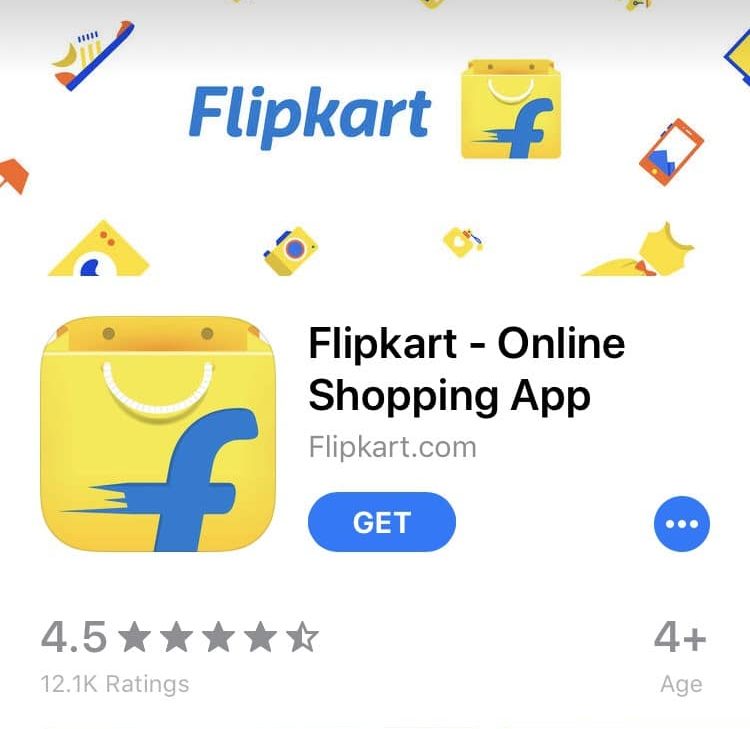
Flipkart Business Model | How does Flipkart make money?
Company: Flipkart.com (a subsidiary of Walmart) Founder: Sachin Bansal, Binny Bansal Year founded: 2007 Headquarter: Bengaluru, India CEO (Jan 2017 – Present): Kalyan Krishnamurthy Number of Employees (2019): 30,000 Public or Private: Private Industry Sector: E-commerce Valuation (Nov 2020): $24.9 Billion Annual Revenue (FY 2019): $6.1 Billion (Rs. 42,878 crore)
Products & Services: consumer electronics | ebooks | fashion | lifestyle products Competitors: Amazon | Snapdeal | Alibaba.com | Paytm | Shopclues
Table of Contents
Introduction to Flipkart, e-Commerce Platform
Flipkart e-Commerce Company was first idealized by Sachin and Binny Bansal in 2007. Both brothers are former Amazon executives. The Bansal brothers were able to successfully design a business module based on their experience and expertise. Their business scheme stood promising that led to the initial funding process from external sources.
Initially, the Bansal brothers invested in a total of $5,600 towards developing an ideal online book store website. 2 years after the initial launch, Flipkart platform stood potential enough to raise $1M from Accel India . They later formed alliances with Tiger Global , raising in a total of $10M in 2010 and $20M in 2011.
Flipkart had also reported that they have completed the 4 th round of funding phase from MIH, a subdivision of Naspers Group and ICONIQ Capital . These funding were harvested for the very reasoning to further explore new business opportunities and venture to new business endeavors that would further improve and grow Flipkart as a company.
In July 2020, Walmart led another startup investment round for $1.2 billion, which raised Flipkart’s valuation to $24.9 billion. The US retailer owns over 90% of Flipkart for $16 bn; it invested in 2018. In September 2020, Walmart invested $560 million in Flipkart as part of the $1.2 billion investment round . [ 1 ]
#10YearChallenge pic.twitter.com/ATqMGmTC1l — Flipkart (@Flipkart) January 16, 2019
Business Model Canvas of Flipkart
Now let’s look at the business model canvas of Flipkart in more detail:
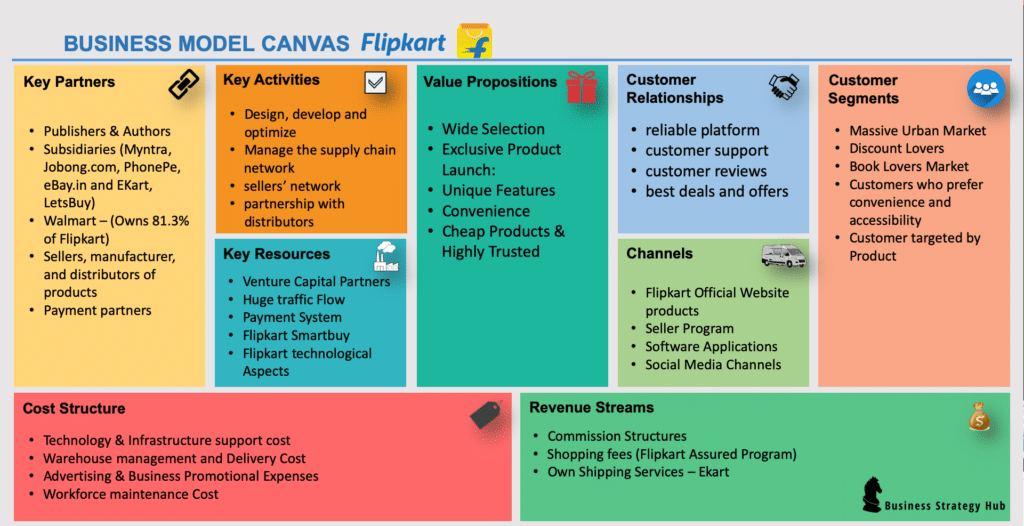
1. Flipkart’s Customer Segments
Massive urban market – who prefers to buy online.
- Flipkart has grown into an enormous platform for a vast marketplace in India for the time being.
- Currently, Flipkart marketplace is only open and available for deliveries to be made anywhere within India.
Discount Lovers – Promotional Offers & Special Pricing for Customers
- Flipkart offers its loyal and new customer(s) promotional offers & special pricing during the holidays.
- They also provide branded products at reasonable prices – This is also a great way to ensure diligent treatment towards loyal customers and help further introduce its products to potential marketplaces.
Book Lovers Market Trend Analysis
- Flipkart originally started selling books and now have expanded to major electronics at a massive scale for adults and children.
Customers who prefer convenience and accessibility
- Flipkart products are easily accessible through their official website.
- Flipkart products can be accessed through Flipkart’s software applications programs. (Google Play & iTunes)
Customer targeted by Product
- Flipkart’s most success is driven by the smart analytics that is evaluated for the market places.
- Its social media platforms are another set of sources that help the analyst identify what consumers are into nowadays, and what is the recent trend.
- Flipkart targets those products that are in high demand to potentially make a sale.
Online Retailers
- Some online retailers don’t have extensive delivery systems and rely on Flipkart via Ekart logistics and shipping services. [ 2 ]
2. Flipkart’s Value Propositions
Exclusive product launch:.
- Electronics
- TVs & Appliances
- Baby & Kids
- Home & Furniture
- Sports, Books & More
Unique Features
- Customer Login & Signup area
- Sell on Flipkart as a Seller
- 24x 7 Customer Services
- Advertise with Flipkart
- Software Application (Dual Interface)
- Flipkart Assured – badge for high-quality products and faster delivery.
Convenience
- Before the Flipkart launch, India consumers used to purchase such goods directly from Amazon, Ali Baba, Snapdeal and other competitive platforms that offer almost the same types of products and services.
- When Flipkart launched with competitive products with low prices, the Indian consumers’ interest rose in the local Indian Amazon, i.e., Flipkart.
- In 2020, it launched Flipkart Wholesale to provide services for the grocery and fashion categories. The expansion is focused on enhancing India’s wholesale ecosystem. To deliver this project, the company acquired Walmart India that operates Best Price, and also plans to provide technical support to Kiranas and MSMEs since they play an integral role in the sector. [ 3 ]
Wide Selection
- Users are able to find just about any type of product, whether it is for the holidays, searching for a gift or just doing some general shopping.
- Flipkart Users are able to search through thousands of different sellers and review the listings that they have.
- Each listing (product) is listed with product specifications and details. Users are able to search through category or through smart search (filter engines)
Cheap Products & Highly Trusted
- One of the best things about Flipkart is that fact that they offer their clients to review the listing from these sellers and other relevant shops that offer their products at the lowest prices as compared to the markets.
- Because of their policies, due diligence, and the positive feedback, Flipkart is highly trusted and recommended by customers who have used the Flipkart services before.
- Trust credibility factors help to increase business potential revenue streams by reference or through retention conversions.
3. Flipkart’s Customer Relationships
Flipkart aims to establish a global recognition as one of the leading e-commerce platforms. Since the initial launch in 2007, Flipkart has built a sound relationship for their loyal customers and followers.
- Flipkart ensures to provide its customers with the best deals and offers that are more beneficial as compared to other competitive companies.
- Flipkart has created a reliable platform that provides quality products with customer reviews .
- Flipkart ensures to provide quality customer support via phone, online chat or email available 24-7.
4. Flipkart’s Key Activities
The following are the major key activities that are conducted daily that help to deploy all the operations of Flipkart
- Design, develop and optimize its ingenious online platform specifically for electronic commerce products for the Indian Regions.
- Manage the supply chain network of its products including logistics, warehouses, etc.
- Hire, train and retain the workforce.
- Product catalog – maintain product catalog with images and videos.
- Build and manage sellers’ network.
- Establish a partnership with distributors and other manufacturers.
- Marketing & Sales promotion including developing an effective Pricing strategy and promotional offers and discounts during shopping peak seasons and holidays.
- Establish a secure payment portal.
- Customer support (24 – 7) via phone, online chat, and email.
- Acquisitions for expansion- To expand into the wholesale sector, Flipkart acquired a 100% stake in Walmart’s India business. This enabled the online retailer to launch Flipkart Wholesale to serve small and medium-sized businesses and neighborhood stores (Kiranas) in India. [ 4 ]
Soak in the sheer size of our largest and busiest warehouse – a place where millions and millions of wishes are fulfilled. #IndiasHappiestWarehouse pic.twitter.com/TSMDvXwu9h — Flipkart (@Flipkart) February 20, 2019
5. Flipkart’s Channels
One of the most significant reasons for Flipkart success is the powerful combination of Flipkart revenue model and other digital marketing schemes that spread like wildfire across the internet, creating its online presence, awareness and helping to further channel Flipkart for opportunities.
- Flipkart Official Website products
- Seller Program
- Affiliation Programs (promotional content)
- Flipkart Plus
The website alone provides additional features, promotional deals and other exclusives that helps it landing pages convert.
Software Applications
- Flipkart Online Shopping App
- Flipkart Seller Hub
Additional accessible platforms like Flipkart software applications help potential customers to process other potential orders.
Social Media Channels
- Google Plus
Through the social media channels, Flipkart is able to publish blogs, news and other promotional material that helps to increase the awareness of Flipkart. Thus, increasing new revenue streams.
6. Flipkart’s Key Partners
In association with the branding phase, Flipkart was built with the assistance of its primary key partners. Each associated member has relevant experience and knowledge in their respective professional field, and took part to make company business models, and other endeavors to motion:
Publishers & Authors
- Flipkart was originally launched as a book buying platform , offering a wide selection of book and eBook for readers to select and purchase.
- The company soon flourished and expanded its line of products , converting the business model to the wider side of the spectrum.
Subsidiaries (Myntra, Jobong.com, PhonePe, eBay.in and EKart, LetsBuy)
- Flipkart’s subsidiaries provide a wide range of products to generate additional revenue with higher profit margins. Some of the new subsidiaries include Mallers, DSYN, Ugenie, Jeeves Consumer Services, and AdiQuity.
- Most of these subsidiaries were launched prior to achieving the financial goals through their financial investors and capital start-up grants.
Walmart – (Owns 81.3% of Flipkart)
- Walmart is an American multinational retail company that operates in multiple sectors.
- Headquartered in Bentonville, Arkansas. On May 2018, Walmart acquired 81.3% of Flipkart. In 2020, Walmart increased its stake in Flipkart by leading a new $1.2 billion financing round to add on top of the $16 billion it invested in the Indian e-commerce giant two years ago. [ 5 ]
Sellers, manufacturer, and distributors of products
Flipkart massive inventory system is supplied by some of the prime titans in India:
- Sellers – Sellers that sell their products or services via Flipkart through means of operating a “store-presence” on the Flipkart platform.
- Flipkart is responsible for delivering the goods. However, the supply chain (products or services) are directed by the supplier/sellers’ end.
- The sellers are responsible for fulfilling the orders that they Sellers claim to sell/promote.
Payment partners
Flipkart has partnered with Banks, Credit card, e-wallet companies to offer secure payment service on its platform. In 2020, it partnered with Paytm to meet the increase in demand during the festive season. The partnership also provided customers a wide variety of offers and benefits under The Big Billion Days festive season sale. [ 6 ]
7. Flipkart’s Key Resources
Initial resources that makeup Flipkart, consists of a group of multiple investors that help fund the structure of Flipkart operations and for further development.
Resources (2007- Present):
Flipkart venture capital funds partners;
- Accel India
- Tiger Global
- MIH (Naspers Group Sector)
- ICONIQ Capital
- In preparation to take on Flipkart’s biggest competition – Amazon. In 2017, Flipkart had $2.5B from Japan’s SoftBank. In 2018, however, SoftBank had sold all (20% stake in Flipkart) of its share to Walmart .
Huge Traffic Flow
- One of the most crucial factors for Flipkart is that fact that its ability to get over 100 million visitors every day . To reduce delays, Flipkart launched a hyperlocal delivery service in July 2020 known as Flipkart Quick, which provides a handpicked assortment of over 2,000 products in categories and delivers to the customer within 90 minutes. Some of the most common products for Flipkart Quick includes grocery, meat, dairy, and other essentials. [ 7 ]
- The conversion rate + recurring loyal customers and the conversion rate from reference or third-person help to generate revenues for the company.
- Flipkart not only do customer come back to shop again through Flipkart channels but also help to create awareness of the company and increase company image.
Payment System
Flipkart platform offers multiple methods for its customers to pay for their orders:
- COD (Cash on Delivery) – The concept that was pioneered by Flipkart has changed the game of e-commerce in Indian Market. A customer that would like to place an order on COD can place orders that do not exceed 50,000 Indian Rupees (Approx. $700). In 2020, Flipkart rolled out partial payments that allow customers to pay part of the total price of a product when they order it and settle the remainder on delivery. The unpaid part of the price is collected via the Cash on Delivery (CoD) system. [ 8 ]
- Credit / Debit Card – During the sign-up phase, clients are required to provide either a credit card or debit card. Such cards can be issued from India or the other 21 countries that Flipkart accepts to do business with.
- Bank’s Internet Banking feature – Customers have the option to sync their Flipkart accounts with their local banking facility to process payments.
Flipkart SmartBuy
- Flipkart’s private label SmartBuy is created to introduce its loyal customers a channel to supply mobile & electronics accessories, home & kitchen appliances at affordable prices.
Flipkart Technological Aspects
- Flipkart’s technology and infrastructure have enabled them to deliver 5 million products per month.
Sachin Bansal – Executive Chairman
- Sachin Bansal (former Amazon Executive) is currently the owner of Flipkart.
- S. Bansal owns about 6% of Flipkart, Inc. shares.
Binny Bansal – Co-founder & CEO (Helping Founders)
- Binny Bansal (former Amazon Executive) is also the owner of Flipkart.
- Binny Bansal is no longer working with Flipkart due to an allegation raised by 81.3% shareholder Walmart. Currently, there hasn’t been any recent releases regarding the allegations.
- B. Bansal was believed to be 5% owner of Flipkart shares.
Kalyan Krishnamurthy – CEO
- Kalyan Krishnamurthy is currently the CEO of Flipkart. Mr. Krishnamurthy mentioned that Flipkart will soon be required to hire additional executives for the company.
- Krishnamurthy is responsible for all the operations that are deployed regularly in the Indian region.
- Flipkart is still considered a domestic company, and Walmart has unveiled plans about continuously keeping Flipkart accessible in its home country – India.
8. Flipkart’s Cost Structure
- Technology & Infrastructure support cost
- Warehouse management and Delivery Cost
- Advertising & Business Promotional Expenses – went up by 9.4% to Rs. 1,188 crores in 2017, as compared with a 100% jump in 2016. Flipkart increased its ad expenses by 56% from Rs 731.3 crores in FY2018 to Rs 1141 crores in FY2019 . The increase is attributed to stiffening competition, which requires Flipkart to pay for more digital ads across several platforms to attract and retain customers. [ 9 ]
- Employee Cost Monthly: The average salary per employee is approx. $981.73 per monthly basis cycle (approx. 70,000 Indian Rupees)
- Employee Cost Annually: There are in total of 30,000 employees x $981.73 average salary = $30 Million
9. Flipkart’s Revenue Streams
Flipkart accumulates its revenue through a few channels. Let’s see how does Flipkart make money?
How does Flipkart make money?
Commission structures.
- Flipkart makes a percentage cut whenever someone sells their product to a customer. Commissions are usually deducted from the original transaction value prior to paying out the seller who sold the item.
The commission structures vary from item to item, they are categorized in the following;
- Low Margin branded categories: 2-5%
- High Margin branded categories: 10-25%
Shopping fees (Flipkart Assured Program)
- Shopper saves more by availing free deliveries on orders that exceed the value of 500 Indian rupees. The saved amounts usually are accumulated and then spent again at Flipkart.
Own Shipping Services – Ekart
- It is a department that makes all the deliveries of goods to the concerned consumer.
- It costs 50 Indian Rupees for items that are less than half a KG (weight)
- Flipkart also makes money using Ekart to ship products of other retailers who have customers in India but lack logistical capabilities.
- The e-commerce giant has been generating a lot of money from paid ads since. It launched a digital ads platform in 2015, which attracted businesses quickly and was generating nearly $1 million in monthly advertisement sales within a year. Flipkart is regarded as one of the largest digital ads platforms in India. [ 10 ]

Final Thoughts
The success of Flipkart may not be very much dependent on the fact that it operates similarly to Amazon , instead because of the market trend and scope in India.
Although there are Amazon facilities designated in India, Flipkart online platform offered similar brands and products, only this time Flipkart doesn’t charge additional international shipping charges and therefore delivery is much cheaper as compared to what Amazon charges. Because of the demand and scope in India existed, the success of Flipkart was made possible.
References & more information
- ET Tech. (2020, Sep 26). Walmart invests $560 million in Flipkart . Economic Times.
- Editor (2020, Sep 29). 700 Kirana stores to assist Flipkart’s Ekart in last-mile delivery . Indian Online Sellers
- Danny Cyril, D. (2020, July 23). Flipkart Wholesale to be launched next month: 5 things to know . Live Mint
- Singh, M. (2020, July 23). Flipkart buys Walmart’s India wholesale business to reach mom and pop stores . Tech Crunch
- Singh, M. (2020, July 14). Walmart leads a $1.2 billion investment in India’s Flipkart . Tech Crunch
- PTI. (2020, Oct 5). Flipkart partners Paytm for festive sale . Economic Times
- Bapna, A. (2020, Sep 30). Brand bounce-back: Flipkart marketing lead expects the Indian festive season to trigger growth . The Drum
- Verma, S. (2020, July 17). Flipkart rolls out partial payments to reduce order cancellations . India Today
- Mansuri, M. (2020, Jan 7). Flipkart Internet upped ad spends by 56% in FY19 . Exchange 4 Media
- Editor. (2020, Sep 9). Flipkart clocks $1mn monthly revenue from paid ads; Launches ‘Brand story ads .’ Indian Online Seller
Tell us what you think? Did you find this article interesting? Share your thoughts and experiences in the comments section below.
A management consultant and entrepreneur. S.K. Gupta understands how to create and implement business strategies. He is passionate about analyzing and writing about businesses.
Cancel reply
Really its very good for me helping me to Growing my future company
Glad you liked the article JP. I wish you all the success for your company !
You may also like

Decoding TikTok’s Business Model | How does TikTok make money?
The internet has shrunk geographies and brought people closer, transforming the world into a global village. With over 5.19 billion internet users across the world, social media platforms command the time and attention...
How Does Venmo Make Money?
Table of Contents Toggle Introduction to VenmoVenmo BusinessVenmo API StructuresVenmo Revenue ModelFinal Thoughts Introduction to Venmo Venmo, a subsidiary of Paypal, is a platform that offers users to transfer funds...
How Does Popmoney Work ?
Last updated: May 18, 2020 Company: Popmoney (Division of Fiserv) CEO: Jeffery W. Yabuki Founders: Sanjeev Dheer Year founded: 2010 Headquarter: New York, NY Products & Services: Peer...
Yelp Business Model | How does Yelp make money?
Company: Yelp CEO: Jeremy Stoppelman Year founded: 2004 Headquarter: San Francisco, California, USA Number of Employees (Dec 2018): 6030 Public or Private: Public Ticker Symbol: YELP Market Cap (March...

What is ProctorU, how it works and makes money?
Company: ProctorU Founders: Jarrod Morgan Year founded: 2008 CEO: Scott McFarland Headquarter: Birmingham, Alabama Number of Employees (Dec 2018): 400+ Type: Private Ticker Symbol: NYSE: UBER Annual Revenue (Dec...

How Does Whatsapp Make Money – Billion $ Startup
Last updated: March 21, 2020 Company: WhatsApp Inc (a subsidiary of Facebook Inc.) CEO: Jan Koum Year founded: 2009 Headquarter: Menlo Park, California, USA Number of Employees (2018): 200 User...

Facebook Business Model | How does Facebook make money?
Company: Facebook, Inc CEO: Mark Zuckerberg Year founded: 2004 Headquarter: Menlo Park, California, USA Number of Employees (June 2020): 52,534 Public or Private: Public Ticker Symbol: FB Market Cap (Nov...

How Does Craigslist Make Money? (2022)
Last updated: May 23, 2020 Company: Craigslist, Inc. Industry: Classified advertisements forum Founder: Craig Newmark CEO: Jim Buckmaster Year founded: 1995 Headquarter: San Francisco, California, United States Number...

Disney’s Business Model | How does Disney make money?
Disney is a world-renowned brand and requires no introduction. This company is an indispensable part of an individual’s life through its TV programs, theme parks, movies, games, and music. However, it is interesting to...

50 Types of Business Models (2022) – The Best Examples of Companies Using It
Last updated: Jan 30, 2021 Are you looking for ideas to unlock your long-term business value? If you shook your head in yes, remember that business model is one of the ways to streamline your business process...
Recent Posts
- Who Owns 7UP?
- Who Owns Buick?
- Who Owns Sprouts Farmers Market?
- Who owns Maserati?
- Who Owns Acura?
- Who Owns Zeus Network?
- Who Owns Dave & Buster’s?
- Who Owns Embassy Suites ?
- Who Owns Wawa ?
- Who Owns Rap Snacks ?
Business Strategy Hub
- A – Z Companies
- Privacy Policy
Subscribe to receive updates from the hub!
- Red Queen Effect
- Blue Ocean Strategy
- Only the paranoid survives
- Co-opetition Strategy
- Mintzberg’s 5 Ps
- Ansoff Matrix
- Target Right Customers
- Product Life Cycle
- Diffusion of Innovation Theory
- Bowman’s Strategic Clock
- Pricing Strategies
- 7S Framework
- Porter’s Five Forces
- Strategy Diamond
- Value Innovation
- PESTLE Analysis
- Gap Analysis
- SWOT Analysis
- Strategy Canvas
- Business Model
- Mission & Vision
- Competitors

- Business Models
Flipkart Business Model, The Winning Steps Behind Its Success
With this digital growth of online shopping, where every click unlocks a world of choices, one name stands tall as a pioneer and a pillar of trust – Flipkart .
Imagine a journey that began with selling books from the cozy confines of an online bookstore, only to evolve into a retail powerhouse, offering everything from cutting-edge gadgets to the trendiest fashion, and even your daily groceries.
In this article we will discuss the captivating growth of the Flipkart business model , unwrapping its secrets to success and unveiling the innovative strategies that have catapulted it to the leader of India’s e-commerce landscape.
Table of Contents
1. Customer-Centric Approach
One of the fundamental pillars of Flipkart’s business model is its unwavering commitment to customer satisfaction. The company understands that success in e-commerce hinges on building trust and delivering exceptional service to customers. To achieve this, Flipkart has invested heavily in customer-centric initiatives such as:
- User-Friendly Interface: Flipkart’s website and mobile app are designed to be intuitive and easy to navigate. This user-friendly approach ensures that customers can find and purchase products with ease.
- Customer Reviews and Ratings: Flipkart allows customers to leave reviews and ratings for products they’ve purchased. This helps prospective buyers make informed decisions and builds trust in the platform.
- Customer Support: The company provides robust customer support through various channels, including chat, email, and phone, to address any issues or concerns promptly.
- Return Policy: Flipkart’s flexible return policy allows customers to return products they are not satisfied with, making the shopping experience risk-free.
2. Diverse Product Portfolio
Over the years, Flipkart has expanded its product categories significantly. While it initially started as a bookstore, it now offers an extensive range of products, including electronics, fashion, home appliances, furniture, beauty products, and even groceries.
This diversification has been crucial to its growth and the ability to cater to the diverse needs of Indian consumers
3. Marketplace Flipkart Business Model
Flipkart primarily operates on a marketplace model, which means it doesn’t own the inventory of most of the products listed on its platform. Instead, it connects buyers with sellers, creating a vast online marketplace. This model allows Flipkart to:
- Scale Rapidly: Without the need to invest heavily in maintaining inventory, Flipkart can scale quickly and add a wide variety of products to its platform.
- Reduce Risk: By not holding inventory, Flipkart mitigates the risk of unsold products and inventory costs.
- Offer Competitive Prices: The marketplace model encourages healthy competition among sellers, leading to competitive prices, which benefit consumers.
4. Logistics and Supply Chain
Efficient logistics and a robust supply chain are the backbone of any successful e-commerce business. Flipkart has invested heavily in building an efficient logistics network, which includes a vast network of warehouses and delivery centers. Some key aspects of Flipkart’s logistics and supply chain include:

- Fulfillment Centers: Flipkart has strategically placed fulfillment centers across India to ensure swift order processing and delivery.
- Last-Mile Delivery: The company focuses on improving last-mile delivery, partnering with local delivery partners to reach even remote areas.
- Technology Integration: Flipkart uses cutting-edge technology to optimize its supply chain, including route planning, inventory management, and order tracking.
- Private Label Brands: Flipkart has introduced its private label brands, such as “Flipkart SmartBuy,” which further streamlines the supply chain and offers quality products at competitive prices.
5. Innovative Payment Solutions
In a country as diverse as India, where access to traditional banking services can be limited, Flipkart has introduced innovative payment solutions to cater to a wider audience. These include:
- Cash on Delivery (COD): Recognizing the preference for cash transactions, Flipkart pioneered the COD payment option, allowing customers to pay in cash upon delivery.
- Digital Wallets: Flipkart accepts payments through popular digital wallets like PhonePe and UPI , making it convenient for customers who prefer cashless transactions.
- Buy Now, Pay Later: The company has also introduced “Buy Now, Pay Later” options in partnership with financial institutions, offering credit to eligible customers.
6. Big Billion Days Sale
Flipkart’s Big Billion Days Sale has become an annual shopping extravaganza in India, offering steep discounts across various product categories. This event not only attracts a massive influx of customers but also creates a sense of urgency and excitement around shopping on the platform. It’s a prime example of how Flipkart leverages marketing and promotional events to boost sales and engage customers.
7. Continuous Innovation
To stay ahead in the competitive e-commerce industry, Flipkart emphasizes continuous innovation. Some notable innovations include:
- Video Shopping: Flipkart introduced “Flipkart Video Shopping,” allowing customers to watch product videos and make informed purchase decisions.
- Augmented Reality (AR): The company has integrated AR technology, enabling customers to visualize how furniture and other products would look in their homes before making a purchase.
- Expansion into New Categories: Flipkart has ventured into new categories like healthcare, insurance, and financial services to diversify its offerings.
Some More Posts
Wrapping up.
Flipkart’s journey from a modest online bookstore to a retail behemoth is a testament to its resilient business model and customer-centric approach. By diversifying its product portfolio, embracing the marketplace model, and investing in logistics and supply chain, Flipkart has managed to capture the hearts of millions of Indian consumers.
Moreover, the company’s commitment to innovation and adapting to the changing needs of customers has helped it maintain its competitive edge. Flipkart’s ability to balance customer satisfaction with operational efficiency has positioned it as a leading player in India’s e-commerce industry , and its business model continues to be a source of inspiration for aspiring entrepreneurs and businesses worldwide.
Frequently Asked Questions (FAQs)
Q1. what is flipkart’s business model.
Flipkart operates primarily on a marketplace model, connecting buyers and sellers without owning most of the inventory. It provides an online platform for various sellers to list and sell their products.
Q2. How did Flipkart start, and what was its initial focus?
Flipkart started in 2007 as an online bookstore, focusing primarily on selling books. It gradually expanded its product categories to become a comprehensive e-commerce platform.
Q3. What makes Flipkart different from other e-commerce platforms?
Flipkart is known for its customer-centric approach, innovative payment solutions, and its annual Big Billion Days Sale. It also offers private label brands and has diversified into various categories beyond traditional e-commerce.
Q4. How does Flipkart handle logistics and delivery?
Flipkart has a robust logistics network with fulfillment centers strategically located across India. It partners with local delivery services for last-mile delivery and employs technology for efficient order processing and tracking.
Q5. What are some of Flipkart’s innovative features?
Flipkart has introduced features like video shopping, augmented reality for visualizing products, and various payment options, including cash on delivery (COD) and digital wallets.
Do You Want To Share Your Startup Story With US? CLICK HERE
Join our community here, recommended stories.

Eighth Episode of Crafting Bharat Podcast Series featuring Tejas Rathod, Co-Founder and COO of Mobavenue, Shares Insights on the Indian Startup Ecosystem

The Secret Ingredient Behind Harvest Gold’s Success

Know How Bonn’s Bread Became a Market Leader in North India

From IT to Strawberry Fields: Nilgiri Man’s Sweet Success in Organic Farming

From Rs 80 to Lakhs: How Anjum’s Kitchen Became a Biryani Sensation

Seventh Episode of Crafting Bharat Podcast: Sravanth Aluru, Avataar Co-Founder & CEO, on AI’s Future & Spatial Storytelling in India
The Flipkart Story in India: From the Start to Walmart
- Asian Journal of Management Cases 1(Online First):1-18
- 1(Online First):1-18

- Christ Academy Institute of Advanced Studies
Abstract and Figures

Discover the world's research
- 25+ million members
- 160+ million publication pages
- 2.3+ billion citations
- Sebastián Fernández Franco

- Nicholas Bamegne Nambie
- Priyadarshini P.

- Gautamkumar Rajkumar
- Ankit Pandey

- P M Dasgupta
- M Chanchani
- A Bhattacharyya
- Recruit researchers
- Join for free
- Login Email Tip: Most researchers use their institutional email address as their ResearchGate login Password Forgot password? Keep me logged in Log in or Continue with Google Welcome back! Please log in. Email · Hint Tip: Most researchers use their institutional email address as their ResearchGate login Password Forgot password? Keep me logged in Log in or Continue with Google No account? Sign up

- Development
- Digital Marketing
Flipkart Case Study: Marketing and Advertising Campaigns
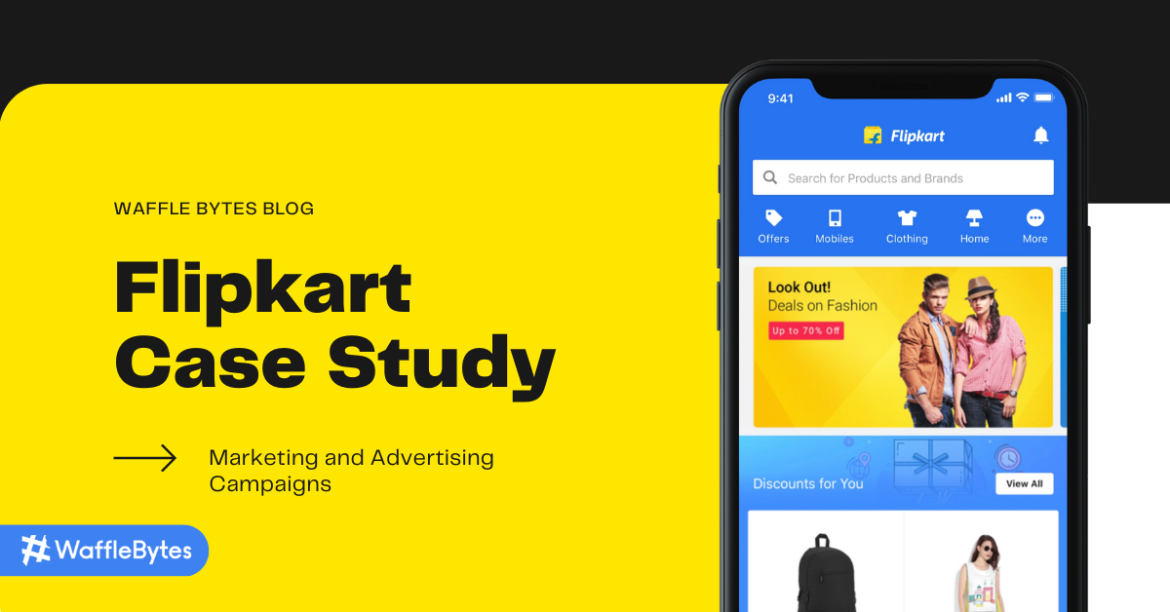
Flipkart is an e-commerce Indian-based online marketplace, founded in 2007 by two friends Sachin Bansal and Binny Bansal . The fact is that Binny Bansal is a former employee of Amazon. Sachin had referred Binny to Amazon, which till then had been working in the company for more than a year.
When Flipkart was launched, it was initially aimed at selling books before expanding into other product categories such as consumer electronics, fashion, home essentials and groceries, and lifestyle products.
According to Redseer, in October 2023, Flipkart had a 64% market share of India’s e-commerce industry.
Flipkart, currently with a strength of 33,000 employees, has 295 million registered users and over 12 million daily visits. Flipkart’s technology has enabled it to deliver 8.5 million shipments per month – and that number is increasing year on year.
According to Crunchbase, The total funding amount to be received by Flipkart by 2023 is US$ 12.9 billion.
| Field Name | Data |
|---|---|
| Legal name | Flipkart Online Private Limited |
| Industry | Retail, E-commerce |
| Headquarters | Bengaluru, India |
| Founding year | 2007 |
| Founders | Sachin Bansal, Binny Bansal |
| Number of employees | 30,000 |
| Total funding | $12.9 billion |
| Revenue 2023 | 67.4 billion |
On This Page:
Flipkart: Warehousing & Shipments
Logistics is one of the most important aspects of any successful e-commerce platform. Flipkart ships more than 100000 items in a day which makes managing the logistics an overwhelming task for the company.
Also, the cost of delivery is paid by the company itself, making logistics a financially complicated issue. Hence in order to successfully manage the logistics. Flipkart uses its in-house logistics known as eKart‟ (EKL).
The e-commerce company created E-Cart as a personal brand in April 2009 to serve the B2C side of WS-Retail, Flipkart and currently reaches consumers in around 150 cities.
eKart currently provides services like Delivery Logistics, Reverse Logistics and cash on Delivery. It also provides customer support and technology integration for order tracking, customer notifications, and reporting.
Digital Marketing Strategies
Let’s look at how Flipkart used digital marketing to promote its products and services.
Flipkart mostly targets Indians who use the internet and don’t have time to visit offline shopping stores. Although its target audience is scattered across different market segments as consumers of all demographic backgrounds can find products of interest to them, 85% of its audience is between the age group of 16 to 55 years.
Search Engine Optimization
If we talk about organic traffic, Flipkart has achieved tremendous results through search engine optimization.

Flipkart is India’s largest online retailer and has worked hard to optimise its website for search engines. Flipkart appears in the top 5 results for every product search, and this is possible because Flipkart has invested heavily in SEO.
Social Media Marketing
Flipkart continues to win over the audience on social media, duly manned by celebrity influencers apart from its roster of brand ambassadors from time to time. They often run campaigns for specific sales, opportunities, and brands.
- Flipkart gets 79.08% of website visits from Youtube.
- From Facebook 7.71%.
- 3.99% of People prefer to share Flipkart products on WhatsApp with friends and relatives. which is a sign of brand management and trust in Flipkart.
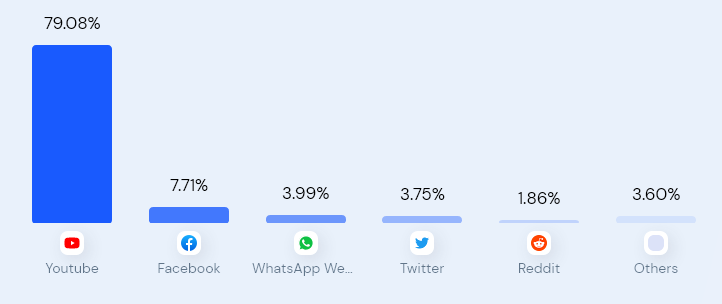
Video Advertisement on YouTube
As the data mentioned above shows that Flipkart gets the most traffic from YouTube. So now have to look at and understand the Flipkart video advertising strategy.
Celebrities Marketing Campaign
Flipkart is known for its collaborations. It also makes particular investments in star power and celebrity marketing. Flipkart keeps on collaborating with various famous personalities year after year.
One of the memorable and recent collaborations was with Ranbir Kapoor and Alia Bhatt on “#IndiaKaFashionCapital”.
Television Ads
Flipkart and its subsidiaries – Myntra and PhonePe – have seen a significant increase in their television commercials since August, when they were acquired by US retail giant Walmart. The last time Flipkart launched a branding campaign with the tagline ‘Ab Har Vish Hogi Puri’ was when it spent massive marketing dollars to create brand awareness.
Affiliate Marketing
Affiliate marketing is commission-based marketing by which a person can earn rewards in the form of commission for marketing the products of another person or company.
Flipkart undertakes the responsibility of marketing its products to third parties known as affiliates and shares a portion of the profit on the sale of the products.
Affiliate programs of e-commerce portals like Flipkart and Amazon are some of the legitimate ways to earn money online in 2022. The Flipkart portal provides almost everything needed for a common man.
From beauty to baby care products to fashion to electronics and from beauty to baby care products, everything can be found on this online portal. All you need is good traffic to your website or blog.
Flipkart vs Amazon
The presence of two of the biggest brands in the Indian market has made the industry highly competitive. Since both have entered the private-label business to increase sales. Both introduced unique features and value-added services and expanded into specific areas to compete with their businesses.
Although Amazon is a world-recognized brand but in India, Flipkart is always 1 step ahead of Amazon.
SWOT Analysis: Flipkart
- The supply chain
- Strong brand value and brand awareness
- Advertising and promotion
- Strategy acquisition
- late delivery
- IT Infrastructure
Business Model of Flipkart
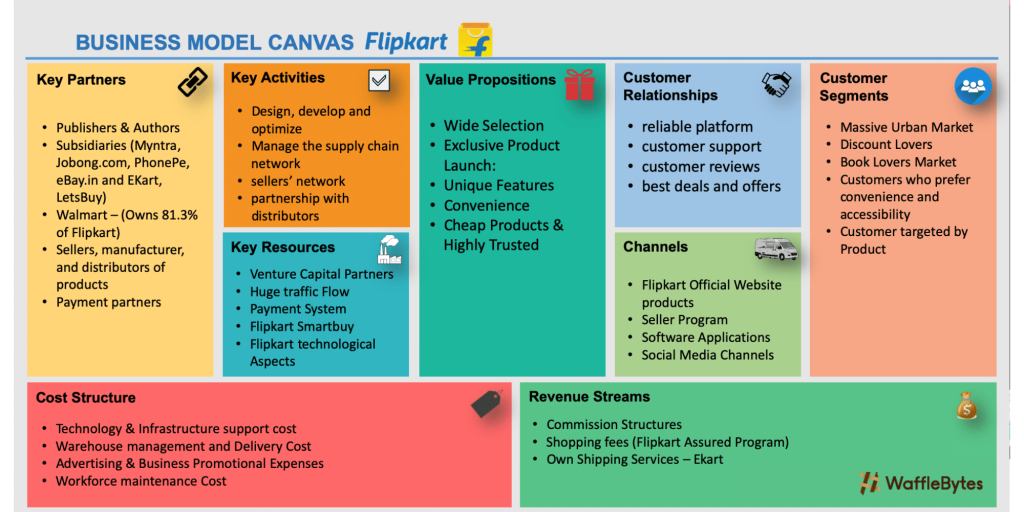
Flipkart, which has redefined shopping in India, operates on a B2C (business-to-consumer model). Flipkart started with a direct-to-consumer model selling books and some other products, before turning to a marketplace model that connects sellers and buyers and expands its catalogue.
Today, it sells everything from smartphones to clothes to furniture to refrigerators to FMCG accessories – and yes, books too.
Flipkart claims to have millions of sellers from across India who list their products in over 80 categories. The average consumer may not care about who the seller is and the relationship he has with Flipkart. Whereas the seller who hasn’t exactly reached out to the customer can now do so thanks to Flipkart’s platform. To facilitate this transaction and fulfil the order, Flipkart charges different percentages as the commission fees from the seller.
List of Flipkart Subsidiaries
Here is the list of 10 Flipkart subsidiaries with a short description and the date of acquiring these companies.
- Myntra – It’s another ecommerce online store acquired by Flipkart in May 2014.
- PhonePe – is an Indian digital payment and financial technology company that Flipkart acquired in April 2016.
- Cleartrip – This is a travel booking search engine globally famous for its incredible service. Flipkart acquired 100 per cent of Cleartrip’s shareholding in April 2021.
- Flipkart Health – This is an online pharmacy, also known as SastaSundar. Flipkart acquired SastaSundar in December 2021.
- Ekart – is a logistics company that delivers 10 million orders per month. Flipkart acquired eKart in 2015.
- Shopsy – Like Flipkart, shopsy is another ecommerce platform that Flipkart acquired in July 2021.
- Flipkart Wholesale – This platform mainly focuses on B2B, in other words, WS retail. We have yet to learn the old name of this company, but Flipkart acquired it in 2012.
- Jeeves-F1 – Jeeves & F1, both part of the Flipkart Group of companies, are among India’s most prominent third-party neutral service providers offering comprehensive lifecycle management for various categories, including Mobility Consumer Electronics, Home Appliances, Furniture, IT & IT Peripherals, AV & Enterprise Solutions.
- Yaantra – is a single window stopover that caters to all smartphone queries, such as broken glass, water damage, software problem, power issue etc. with the best in the industry services. Flipkart Group acquired electronics ecommerce firm Yaantra in January 2022.
- ANS Commerce – is India’s #1 full-stack e-commerce enabler helping brands sell online. Flipkart acquired ANS Commerce in June 2022 to strengthen its e-commerce system via technological innovation.
In Conclusion
However, the situation is not as dire as it may seem. Flipkart’s magical Bansal touch may have disappeared, but its collective expertise and experience to deal with the Indian audience live on. The quick solution to tackle COVID-19 and offering essential items to the cities by Flipkart is commendable. However, e-retailers should seek to gain their market share by winning the trust of their customers rather than money.
Thanks for visiting Waffle Bytes Blog !
Waffle Bytes
Ecommerce website development cost in india: a reality check, 8 tips for getting 100k views on reels., you may also like, canva business model: how canva makes money., candy crush: marketing strategy with psychological appeal, dream11 business model: revenue and operations, leave a comment cancel reply.
Save my name, email, and website in this browser for the next time I comment.
WhatsApp us
Future of Insurance: Learnings from Varun Dua, Founder & CEO Acko

How to build Digital-first Brands: The Flipkart Story

Building Digital-First Brands
The Inspiring Flipkart Journey

Phase 1 - Laying the Groundwork (2008-2014)
In 2008, Flipkart entered the market as a simple online bookstore, quickly expanding its distribution network and prioritizing customer satisfaction. By doing so, they set the stage for the e-commerce revolution in India.

Phase 2 - The Thrilling Rivalry (2014-2017)
The years 2014 to 2017 saw an intense competition between Flipkart and Amazon. This period shaped the Indian e-commerce landscape, with both companies pushing their limits to outperform each other, leading to innovative solutions and faster growth.

Phase 3 - Fortifying the Empire (2018 onwards)
In the face of emerging competition, Flipkart focused on solidifying its market dominance by strengthening its core business, innovating in new verticals, and continuously improving its customer experience.

Building a Resilient Brand - Lessons from Flipkart
Flipkart's success can be attributed to its authentic two-way communication, willingness to adapt and evolve as a brand, and its do-think-do approach, which emphasizes action, learning, and iteration.

Reviving the Titan
To stay ahead, Flipkart continually revisited its core strengths, streamlined processes for maximum efficiency, and pursued relentless execution of its strategies.
Nurturing the Customer Funnel
Flipkart captivated users by engaging them through innovative campaigns and promotions. This, in turn, boosted customer lifetime value and opened up opportunities for the company to venture into new verticals.

Flipkart's Iconic Brand Odyssey
Flipkart's journey serves as a blueprint for digital-first success, demonstrating how resilience, innovation, and a customer-centric approach can carve out a unique and lasting legacy in a competitive market.

The insightful conversation in its entirety can be view below:
Or, you can scan through the main points from the conversation below:
At a high-level, Flipkart’s pre-Walmart acquisition journey can be divided into three phases:
- Phase 1 was the foundational phase between 2008 and 2014. Flipkart initially focused on selling books, building India-wide distribution network, and providing great customer experience to early adopters of the service. After cracking that, Flipkart expanded to electronics in 2011 and acquired Myntra in 2014. Flipkart held its first Big Billion Day sale in 2014.
- Phase 2 was the intense competition phase . Amazon launched its marketplace in India in 2013 and, in 2014, announced that it will invest at least $2B to grow its footprint in India. So, the race to dominate Indian e-commerce started in earnest in 2014. Between 2015 and 2017, there was an intense fight between Flipkart and Amazon.
- Phase 3 : By early 2018, it was becoming clear that Flipkart would be able to hold its ground against the much larger and much stronger competitor. This led to the consolidation phase for Flipkart. In this phase, it was important for Flipkart to strengthen its lead and to ensure that the advantage does not slip away.
In the first phase, Flipkart had laid for building a strong brand by focusing on providing great customer experience. Flipkart also used Cash-on-Delivery (CoD) to build trust with customers.
Shoumyan mentioned three lessons and guidelines from these early efforts:
[1] For digital-first brands (and increasing for all brands), “brand” is what one consumer tells another about the company (as opposed to pre-social media days when “brand” used to be what companies proclaimed themselves to be).
What used to be one-way communication from brands to consumers two decades ago has evolved into two-way communication between brands and consumers. Social media has not only provided a voice to the consumers but have also increased their circle of influence. This implies that brands need to consciously shape consumer narrative around the brand.
Based on this understanding, Flipkart’s marketing team had dual charter:
1. Make people transact with the brand
2. Make people to talk about the brand
Flipkart consciously worked to drive conversations about Flipkart amongst consumers.
[2] Brands — just like two human beings — go through stages of evolution. These stages are:
Unknown → Known → Known for something → Trusted → Loved
While building brands, marketers should not use marketing activities only for tactical reasons (e.g., using TV commercials to build awareness or leveraging discounts to get volumes). A strategic approach is to align the actions with the stage of the brand.
How did Flipkart move across these stages?
- Unknown → Known: Flipkart relied on superior quality of service and concomitant word-of-mouth in the initial stages. In the next stage, Flipkart leveraged performance marketing and communication channels (including advertising). This is when Flipkart identified the “kidult” theme (kids shown as grownup adults).
- Known → Known for something: Flipkart worked on making itself a destination for online shopping that was as easy as a child’s play. It also promoted itself as the destination for buying the latest and the coolest smartphones.
- Known for something → Trusted: Flipkart worked to communicate that consumers can’t go wrong with Flipkart. In order to make itself as a trusted destination for e-commerce across the whole country, Flipkart emphasized cash-on-delivery, original products, etc. This was reiterated by the “Flipkart Assured” program and supported by the “Flipkart matlab bilkul pakka” campaign.
- Trusted → Loved: It is important to move beyond the transactional value for this phase. Flipkart did this by thoughtfully identifying the “purpose” context that was aligned with its mission. Flipkart emphasized that it was an Indian brand that stood for everything that makes India progressive. For example, Flipkart embraced diversity of India. Shoumyan mentioned that one of his favorite themes of this phase were the “Penguin dad” campaign that celebrated fathers helping out their wives by sharing the parenting responsibilities.
How can a brand measure whether or not it is making progress across these stages? Shoumyan mentioned the following metrics:
- Unknown → Known: search volume, top-of-mind recall, and spontaneous recall (brand should be amongst the top 3–4 most aware players in the chosen category).
- Known → Known for something: consumer perception on key attributes (in order to measure that Flipkart as the destination for the coolest/latest smartphones, the scores should be the highest amongst all players), social NPS (to reflect that consumer voice is building up), acquisition funnel measures (for example, CAC and cost-of-installs should decrease).
- Known for something → Trusted: measurement about trust attributes and levers (whether they are going up or not; for example, what percentage of sales come from “Flipkart assured”, “original products”, etc. anchors). Also, in this stage, spontaneous recall should be in mid- to late-90s and almost everyone should knows what the brand stands for. In addition, the brand should get higher repeats leading to higher LTV (life-time value) of customers.
- Trusted → Loved: customers should become more forgiving of mistakes and less price sensitive.
[3] Non-digital (“traditional”) brands operate with the think-do-think model; however, digital-first brands need to adopt do-think-do model of execution. This is because, unlike traditional brands (say, FMCG brands), launch of a product can take 18 months. Digital world moves much faster and, therefore, digital-first brands need to “fail fast and learn faster”.
In 2015, Flipkart had ~45% marketshare while Amazon had ~10% marketshare. This changed dramatically in 2016: Flipkart’s share reduced to ~35%, Amazon grew to ~25%. Flipkart was rapidly losing the marketshare to Amazon… and, from the outside, it looked like Amazon might win the war. But then something changed. Flipkart was not only able to hold on to its marketshare and but slowly increase it. What triggered this turnaround?
Shoumyan pointed out that Flipkart started by turnaround by fixing the mistakes that had crept into its consumer strategy. In order to improve unit economics (to move quicker towards profitability) and to enhance its reach, Flipkart had adopted the marketplace strategy for expansion. However, the marketplace strategy (due to lack of oversight and control) caused the user experience to degrade and for consumer trust to get eroded (to an extent). This is what provided a foothold to the competitors.
Flipkart recognized these mistakes and adopted three-pronged strategy to fix this and move forward:
- Getting focus back
- Get more out of less
- Relentless execution
[1] Getting focus back
First and foremost, Flipkart decided to focus on value-seeking, middle India consumers. As a result of this focus, Flipkart changed its focus on categories, products, etc. Shoumyan pointed out that any strategy has two parts: what you will do and what you will not do. As a consequence of focus on middle India consumers, Flipkart consciously decided to not fight the battle for experience-seeking affluent consumers in Tier 1 cities.
Even more importantly, Flipkart really understood what value meant: it meant more benefits for a given price. And, importantly, it didn’t mean the lowest price and it didn’t mean the biggest discount. As a result, Flipkart explore how to provide more benefits for a given price-point (instead of working towards reducing the price points).
This influenced not only the Flipkart product user experience but also helped identify the right promotional model. It also helped Flipkart prioritize entry into consumer finance and other Fintech products.
As an example, Shoumyan’s talked about “Itne mein itna” campaign during this phase, which emphasized more benefits for a given price point.
[2] Getting more out of less
To get more out of less, Flipkart used a 2x2 matrix with effectiveness and efficiency. This helped Flipkart track the effectiveness and efficiency of marketing spends across social media (engagement rate vs cost of engagement), performance marketing (cost-per install vs average revenue per install over 14 day period), etc.
Flipkart used this matrix to double-down on channels and activities that were yielding results while eliminating those that were not. It helped to figure out which sources maximized effectiveness while increasing efficiency.
It was also used for allocating marketing (Search Engine Marketing) budget across different categories. For each category, SEM spends were plotted against RPC (revenue per click). Flipkart found that for each category, there are specific levels of SEM spends for which RPC gets maximized; beyond this threshold, the marketing spends yield diminishing returns.
Flipkart used this mechanism to optimize its SEM spends. During this intense competition period, Flipkart found that the competitors — despite spending four times more advertising money — had got only 20% additional boost in revenue.
[3] Relentless execution
Core values in the marketing team: Creative excellence, Frugality, and Marketing Innovation.
For brand marketing perspective, creative excellence is critical because if creative is good, it helps the company to achieve its goal by spend less money. If the message is sharp, brand can get the same effect with lower budget. The other way to eliminate misattribution is to pick a unique “device” or theme. For Flipkart, kidadults device helped it to cut through all the clutter. Frugality has two aspects: how to “get more out of less” and how to reduce ineffective spends. Frugality also meant being data-driven about measuring effectiveness of the marketing activities.
Flipkart really pushed the boundaries in marketing innovation and continuously experimented with new things. Shoumyan pointed out that, at one point, almost half of new innovations done by Google and Facebook were done in collaboration with Flipkart. As an example, Flipkart took personalization to the next level by creating more than 3 million personalized video assets. This helped to improve conversion by 45%!
After establishing and retaining lead over Amazon, it would have been tempting to take the foot off the pedal. But Flipkart didn’t do this. Flipkart, instead, consolidated its lead and ensured that its advantage didn’t slip away. What did Flipkart do to become more efficient and more effective during this period?
Flipkart ensured that the — though the victory was celebrated — it didn’t make Flipkart lose the focus or to let complacency set in.
First, Flipkart worked to strengthen the customer funnel and explored how it can engage users better to increase customer LTV.
This was done after segmenting the users and developing a clear understanding of customer requirements. Flipkart used behavioral customer segmentation process. Shoumyan pointed out that any customer segmentation mechanism (based on demographics, psychographics, etc.) can be used as long as it provides Mutually Exclusive and Collectively Exhaustive (MECE) segments. Another important requirement is that the segments should be targetable and actionable.
Flipkart used the behavioral segmentation to divide consumers into 5 segments:
1. Browsers,
2. Lapsers,
3. Light users,
4. Heavy users, and
5. Super-heavy users.
Behavioral segments were created on the basis of Frequency and AOV ( Average Order Value ). Shoumyan pointed out that it would be create behavioral segments using contribution margin (in addition to AOV) in order to assess whether the customers were value building or value eroding.
Based on customer segments, Flipkart knew how to engage with the customers and what were the key tasks they wanted to achieve. For example:
- Browsers and lapsers: acquire more new users or re-acquire old users (and engage them to deliver the initial value)
- Light users and Heavy users: drive more usage by increasing frequency of purchases
- Heavy user and Super-heavy users: make them upgrade to higher order products and make them buy across categories
For each of these segments, Flipkart created separate marketing programs and defined the relevant metrics. For the browsers and lapsers, Flipkart marketing team designed acquisition programs and reactivation programs. For the light users and heavy users, Flipkart designed upsell/cross-sell program and created loyalty program. And so on. Overall, the goal was to make it easier for Flipkart to acquire users and then move them faster across the customer journey (from light to heavy to super-heavy users). In parallel, the goals was to make the customer bucket less leaky and to reduce the number of lapsers.
Second, Flipkart looked at vertical businesses to leverage them to complement the horizontal e-commerce platform. As part of this, Flipkart expanded to launch fashion, household goods, small and large appliances, baby, grocery, etc. verticals. The goal was to expand beyond the smartphones and electronics, apparel (esp. sarees), and branded goods (such as shoes) verticals.
Flipkart also forayed into non-ecommerce categories such as travel bookings, phone recharges, Flipkart videos, etc. The goal was to either maximize transactions or to maximize time spent with Flipkart. In other words, either more units sold or more DAU (Daily Active Users). Appliances, baby, grocery, etc. verticals were geared towards more units while videos, recharges, etc. were geared toward more DAUs.
Flipkart’s brand journey provides a good template for digital-first brands to chart out their journey. In addition to sharing the frameworks and principles for building digital-first brands, Shoumyan also answered a number of questions from the community members. We will share a summary of some of those in a separate post. In the mean time, if you have any comments and questions about Flipkart’s brand journey or the journey of any other digital-first brand, please do let us know.
Everyone in the startup ecosystem has heard about the main Flipkart story… and it is a fascinating story because it had many interesting characters, a lot of suspense and many sub-plots. Flipkart’s efforts to build a brand that was accessible to all Indians — not just to consumers in metros but also to consumers in Tier 2, 3, 4 cities across India — was a wonderful sub-plot. Shoumyan Biswas spent six fruitful years with Flipkart between 2013 and 2019 and was the Chief Marketing Officer ( CMO ) for Flipkart starting 2017 and CMO and Business Head of Loyalty, Partnerships & Advertising for Flipkart towards the end. We requested Shoumyan to share details about this aspect of Flipkart’s journey.
Related Articles:
- The story of Zomentum — Accel’s Perspective
- Untold Seed Stories: First 500 Days of Urban Company
- Untold Seed Stories: First 500 Days of Swiggy
- Untold Seed Stories: First 500 Days of Ninjacart
Join our exclusive Bharat community
- Best-in-class Bharat-focused content offering actionable insight for founders and operators
- Specially curated events and thematic summits
Enter Details
We’re looking for the next generation of successful Indian marketplaces. If you’re an early-stage marketplace founder, apply now here or learn more about the #DecodingMarketplaces Startup Hunt.
We’d love to hear about your experiences with marketplaces. Let us share our learnings and build a better and stronger ecosystem. Write to us at [email protected] to be a part of the Accel family.

Subscribe to SeedToScale
/subscribe to get the latest stories from SeedToScale/
/Previous Article
/Next Article
/Feeling Lucky
Load a random article
/Explore by Topics
AI Powered Summary
Use this soundscape to help you with knowledge retention or long periods of reading.

Flipkart - The Journey of India's Leading E-Commerce Website

Rishabh Rathi , Manisha Mishra
Company Profile is an initiative by StartupTalky to publish verified information on different startups and organizations.
Don’t you think online buying and selling have become an essential part of our lives? It was youth and adults who initially relied on the Internet to buy products at affordable prices with amazing return policies and guarantees; it was a trend back then.
Nowadays, eCommerce websites have made online shopping a common practice for people of all ages. Flipkart is India's most popular e-commerce website, known for its innovative business model.
Flipkart is the leading Indian eCommerce website founded by Sachin Bansal and Binny Bansal in 2007 . The company is headquartered in Bengaluru , India. This Indian eCommerce store has brought a revolution to the Indian e-retail industry.
Let's now delve into the success story of Flipkart and learn about Flipkart's founders, subsidiaries, owners, business and revenue model, and more.
Flipkart: Company Highlights
| Company Name | Flipkart |
|---|---|
| Headquarter | Bengaluru, India |
| Sector | E-commerce |
| Founders | Sachin Bansal, Binny Bansal |
| Founded | 2007 |
| Parent Organization | Walmart |
| Website | flipkart.com |
Flipkart - About Flipkart - Industry and Target Market Size Flipkart - Founders and Team Flipkart - Startup Story Flipkart - Mission Flipkart - Name, Tagline, and Logo Flipkart - Parent Organization Flipkart - Subsidiaries Flipkart - Business Model and Revenue Model Flipkart - Partnerships Flipkart - Funding and Investors Flipkart - ESOPs Flipkart - Growth and Revenues Flipkart - Product And Service Flipkart - Investments Flipkart - Mergers and Acquisitions Flipkart - Challenges Flipkart - Competitors Flipkart - Future Plans
Flipkart - About
Flipkart, an Indian eCommerce company founded in 2007 by Sachin Bansal and Binny Bansal, has become a household name. Based in Bengaluru, India, Flipkart has been selling a vast range of products online, similar to Amazon.
Its phenomenal marketing strategies have attracted the attention of retail giant Walmart, which acquired Flipkart for $16 billion in May 2018.
Along with the imposing worldwide market share that Walmart has in the retail industry, the Sam Walton -founded company is also famous for its inspirational business model.
In the initial years, Flipkart focused on selling books, but today the catalog covers categories like electronics, fashion, home essentials, groceries, and lifestyle products. More than 1 billion people have shopped on Flipkart, making the e-commerce giant the leading e-retailer in India.
Flipkart also has subsidiaries like Myntra , eBay, Ekart, Jeeves, and more. Flipkart also launched Shopsy on July 2, 2021, which is designed to behave like an app that will encourage the nation's entrepreneurs to reap all the benefits of digital eCommerce that come their way without investments.
Today, Flipkart has over 100 million registered users, 100+ thousand sellers, and 21+ state-of-the-art warehouses.
It also boasts about 10+ million daily page visits and over 8 million shipments per month. Flipkart currently works as a subsidiary of Walmart .
The current CEO of Flipkart Group is Kalyan Krishnamurthy .
Flipkart acquired a 100% stake in Walmart India, which operates the Best Price cash-and-carry business.
Thus, we are launching Flipkart Wholesale. This step helped Flipkart strengthen its hold on the grocery, food, and fashion businesses, which are stated to be highly competitive in this dynamic environment.
The launch of Flipkart Wholesale will be initiated in August, thus piloting the services for the grocery and fashion categories.

"The Best Price operation will continue to run as it is. In terms of legal structure, currently, Walmart India is a separate entity within the Flipkart Group", Said Sameer Aggarwal, CEO, Walmart India.
The role of Kirana Stores and MSMEs in India's retail ecosystem is vital. With a focus on meeting their needs, Flipkart Wholesale is all set to widen opportunities at a significant value. By leveraging their expertise and knowledge, the team is breaking new norms and helping Indian businesses grow and succeed.
Earlier in 2018, Flipkart was acquired by Walmart for $16 billion , which was the largest online e-commerce acquisition in the world to the present. Flipkart launched its wholesale unit with a presence in the fashion and grocery categories.
“With the launch of Flipkart Wholesale , we will now extend our capabilities across technology, logistics and finance to small businesses across the country,” Said Kalyan Krishnamurthy , CEO, Flipkart Group
At present, Flipkart Wholesale will be headed by Adarsh Menon (a veteran at Flipkart). In order to ensure smooth functioning and transition, Sameer Aggarwal (CEO, Walmart India) will remain with the company for a while.
Flipkart - Industry and Target Market Size
Flipkart uses an undifferentiated targeting strategy since people of all demographies purchase items online, which are available to everyone where delivery is possible.
National and multinational e-commerce companies are giving neck-to-neck competition to each other, due to which their positioning is very important. Flipkart has positioned itself as a trustworthy and customer-friendly eCommerce brand.
The online retail industry market is of a size of around $60 billion . It is expected to reach $200 billion by the year 2026. The Indian and global e-commerce industry is on the verge of exponential growth, and the introduction of high-speed internet has fueled the process across the nation.
Before the pandemic, India was one of the most attractive eCommerce markets globally, expected to deliver a 30% CAGR over a six-year time horizon, according to a report by RedSeer Consulting.
Flipkart - Founders and Team
Flipkart was founded by Sachin Bansal and Binny Bansal in May 2007.
| Flipkart Founder | Education |
|---|---|
| Sachin Bansal | Bachelor of Engineering in Computer Science and Engineering from Indian Institute of Technology Delhi (IIT Delhi) |
| Binny Bansal | Bachelor of Engineering in Computer Science and Engineering from Indian Institute of Technology Delhi (IIT Delhi) |

Kalyan Krishnamurthy is the CEO of the company. He was appointed CEO of the company in January 2017, when he replaced Binny Bansal.
Sachin Bansal
Sachin Bansal is the co-founder of Flipkart. After obtaining a Bachelor's Degree in Computer Science from IIT Delhi, Sachin started with Amazon as a Senior Software Engineer after a brief stint at Techspan. He then left his job at Amazon and co-founded Flipkart.
At Flipkart, he managed the positions of CEO and Chairman before resigning in 2018 following Walmart's major acquisition of Flipkart, where the American multinational company acquired around 77% stakes in the Indian e-commerce company. Bansal eventually started Navi with Ankit Agarwal and is currently serving as Chairman at Navi. The net worth of Sachin Bansal is currently at $1.30 billion, as of the Forbes report of 2022.
Binny Bansal
An IIT Delhi alumnus, much like Sachin, Binny completed his Bachelor's in Computer Science and Engineering, after which he co-founded Flipkart. Binny Bansal was the COO and CEO of Flipkart.
Sachin was the CEO since the inception of Flipkart,, and in 2016, Binny Bansal took over as CEO while Sachin Bansal became the executive chairman of the company. However, Binny also resigned from Flipkart in 2018 due to personal misconduct allegations against Flipkart.
Bansal also served as the group CEO of the organization. Moreover, Binny has also served as a board advisor at Acko, Blackbuck, GreyOrange, Udhyam Learning, and more such companies. Binny Bansal is currently serving as a co-founder and executive chairman at xto10x Technologies.
The net worth of Binny Bansal is also $1.30 billion, as reported by Forbes in 2022. Apart from serving in the SaaS consulting startup, Bansal was also on the Board of Directors of PhonePe.
Binny Bansal sold stakes worth $264 million (nearly Rs 2,060 crore) to Tencent, as per official documents checked out on June 13, 2022.
The documents revealed that the transaction had already been done in October 2021 and was shared only at the start of FY22.
At the end of the transaction, Binny Bansal was holding around 1.84% of the stakes, while Tencent was currently holding 0.72%. The Chinese tech giant is holding around 4-5% stakes in Flipkart Pte, which is the Singapore-based parent of Flipkart.
Binny Bansal has a history of selling stakes. He had previously sold stakes worth $90 million in 2019 to Tiger Global across two deals. Bansal also sold shares worth $76 million to FIT Holdings SARL, the Luxembourg entity that is owned and operated by Walmart, in the same year.
Flipkart's SVP, Growth and Monetisation, and Shopsy Head, Prakash Sikaria, are exiting after the festival sales, as per reports dated July 22, 2022. Sikaria also headed other verticals like recommerce and travel, which will now be taken over by Adarsh Menon.
On the other hand, Flipkart Wholesale, the B2B e-commerce business of Flipkart, will be headed by Koteshwar LN. However, Flipkart has yet to decide who to appoint for the other functions that Sikaria handled.
Flipkart currently operates with an employee strength of 33,000+ employees.

Flaunt your startup with StartupTalky
800+ stories, thousands of founders, and millions of visitors. Want to be the next?
StartupTalky is where founders, entrepreneurs, startups and businesses hang out and look up to for inspiration. If you have the means, we have the medium! Inviting founders and startups who are building sustainable solutions from ground zero! Startups who run the show, StartupTalky will let the world know!
Flipkart - Startup Story
The IIT-Delhi graduates, Sachin and Binny Bansal, were employees at Amazon when they began thinking of building their own company in India.
Though Sachin was an employee working with Amazon for some time, Binny was referred to join the company by Sachin, and the former appeared to be quite bored with the company.
It was like a "12 to 3 job or something" for Binny Bansal, who decided to quit the company as soon as Sachin and he emerged with the idea of establishing an eCommerce business.
Sachin and Binny started Flipkart as an online book store from a two-bedroom apartment in Bengaluru’s Koramangala area. They initially started with funding of Rs 4,00,000 from their own pockets.
When Sachin and Binny received a positive response and success in selling books back in 2007, they planned to expand to electronics as well, and by 2014, the company had become one of India’s most valuable startups by reaching a valuation of $1 billion.
When the duo founded Flipkart, online shopping in India was even a distant dream for them, but the hard work and consistency paid off and made Sachin and Binny into widely successful entrepreneurs, which placed them quite ahead in the list of the successful Indian entrepreneurs .
Flipkart - Mission
Flipkart's mission is to provide a delightful customer experience by being the partner of choice for Indians and to create India's most customer-centric company.

Flipkart - Name, Tagline, and Logo

The founders of Flipkart, Sachin Bansal and Binny Bansal, wanted a name that could speak beyond books .
Furthermore, they also wanted to name their company in such a way that it would be suitable for a wide range of product categories that could also be expanded in the future.
Flipkart means ‘ flipping things into a shopping cart ’.
The logo of Flipkart was changed twice. There have been several taglines that the company has gone through on different occasions. Some of the popular taglines are:
- Ab Har Wish Hogi Poori
- Abhi Nahi To Kabhi Nahi
- If it's trendy, it is on Flipkart
- Be Trendy, Always
- Itne mein, Itnaaaa Milega
- Shopping ka naya address
- Ab Mehengaayi Giregi
Flipkart - Parent Organization
In August 2018, U.S.-based retail chain Walmart acquired a 77% controlling stake in Flipkart for $16 billion, valuing the company at $20 billion.
With this acquisition, Walmart claimed that the omnichannel retail sector has a huge potential for future growth.
Speaking at Retail India Summit and Expo, Walmart India President and CEO Krish Iyer claimed that
"$16 billion deal to acquire Flipkart has attracted foreign and domestic investors in country's retail and omni-channel space. The recent investment in Flipkart shows Walmart is committed to the country. We do see a great value in terms of an omnichannel play in the whole process"
Owing to the demonetization, he said that it played a crucial role in the growth of the retail sector by structuring the economy along with the implementation of the GST.
These stakes were further increased to 81.3% towards the end of the same year. Soon after the acquisition, one of the founders of Flipkart, Sachin Bansal,,, left the company.
This year, Walmart invested $3.5 billion to boost its ownership of Flipkart to 80.5%. Notably, some of Flipkart's early investors, such as Tiger Global and Accel, divested their stakes by selling them to Walmart.
Walmart Inc. is an American multinational retail corporation that operates a chain of hypermarkets, discount department stores, and grocery stores.
Flipkart - Subsidiaries
The subsidiaries of Flipkart are Myntra, Mallers, eBay, Ekart, Jeeves, Mech Mocha, Upstream Commerce, Ugenie, DSYN Technologies, AdIQuity Technologies, Jabong, ClearTrip, Shopsy, Yaantra, Liv.Ai, F1 Info Solutions and Services, Fx Mart, Appiterate, ngpay, Mime360, WeRead, Chakpak, and Sasta Sundar.
| Company | Acquisition/Launch Date |
|---|---|
| Yaantra | Jan 2022 |
| Sasta Sundar | Nov 2021 |
| Shopsy | July 2021 |
| ClearTrip | Apr 2021 |
| Mech Mocha | Nov 2020 |
| Upstream Commerce | Sep 2018 |
| Liv.ai | Aug 2018 |
| F1 Info Solutions & Services | Sept 2017 |
| eBay India | Apr 2017 |
| PhonePe | Apr 2016 |
| Jabong | July 2016 |
| Fx Mart | Sep 2015 |
| Ekart | Sep 2015 |
| Appiterate | Apr 2015 |
| DSYN Technologies | Apr 2015 |
| AdIQuity | Mar 2015 |
| Jeeves | 2014 |
| ngpay | Sep 2014 |
| Myntra | May 2014 |
| LetsBuy.com | Feb 2012 |
| ChakPak Digital Catalogue | Nov 2011 |
| Mime360 | Oct 2011 |
| Mallers | Oct 2011 |
| WeRead | Dec 2010 |
| Ugenie | Apr 2010 |
In 2016, Flipkart Group acquired PhonePe . However, in December 2022, Walmart-owned Flipkart and PhonePe declared a full ownership separation, with Flipkart no longer holding any stake in the payments firm PhonePe.
Flipkart - Business Model and Revenue Model
Flipkart works on a B2C business model i.e., a business-to-consumer model. The company initially began with a direct-consumer model, wherein it sold books and some other products.
Today, it has become a marketplace with a huge catalog of products—right from FMCG to electronics and books.
Flipkart claims it has over 80 categories and over a million sellers on board from all across India.
It is an omni-channel service provider that leveraged the same model after the Walmart acquisition of Flipkart. The company earns almost all of its operating revenues from the sale of goods.
At Recode’s Code Commerce conference, Binny Bansal, who co-founded Flipkart along with Sachin Bansal, said:
“Sometime in the future, especially with some categories, omnichannel would make a ton of sense. It is definitely something which would be there in the future.
Flipkart - Partnerships
Flipkart has seen a wide range of partnerships throughout the years it has been active. Some of the most prominent of its partnerships are:
Adani Group
The Indian eCommerce marketplace announced a strategic and commercial partnership with the Adani Group on April 12, 2021, to enhance its supply chain and logistics infrastructure.
IIM Sambalpur
The eCommerce major partnered with the Indian Institute of Management, Sambalpur in August 2021, with the aim of supporting and promoting small businesses.
Flipkart partnered with Urbanic on September 8, 2021, to target young consumers across India.
Flipkart started collaborating with the leading Indian kids' fashion brand, Hopscotch on November 25, 2021, to strengthen its kids' fashion segment.
The popular audio streaming service, Pocket FM, has partnered with Flipkart on July 26, 2022, which will be a tie-up for its distribution via the famous e-commerce marketplace.

Flipkart - Funding and Investors
Flipkart has raised $14.3 billion in funding in 27 rounds.
Below are some of the funding details:
| Date | Stage | Amount | Investors |
|---|---|---|---|
| Jul 31, 2023 | Secondary Market | $1.4 billion | Walmart |
| June 13, 2022 | Secondary Market | $264 million | Tencent |
| January 5, 2021 | - | $233 million | Flipkart Pvt. Ltd |
| July 12, 2021 | Private Equity Fund | $3.6 billion | Softbank Vision Fund, Canada Pension Plan Investment Board, GIC, Walmart |
| September 16, 2020 | Corporate Round | $62.8 million | Tencent |
| July 14, 2020 | Corporate Round | $1.2 billion | Walmart |
| December 3, 2019 | Corporate Round | $28.4 million | - |
| September 10, 2019 | Corporate Round | $217 million | Flipkart |
| September 4, 2019 | Secondary Market | $14.5 million | - |
| January 16, 2019 | Corporate Equity | $200.8 million | Flipkart |
| October 25, 2017 | Corporate Round | - | eBay |
| September 18, 2017 | Debt Financing | $133.9 million | SoftBank Vision Fund |
| August 10, 2017 | Secondary Market | $1 billion | SoftBank Vision Fund |
Flipkart's valuation exceeded $40 billion in 2022, and it was preparing for its upcoming public listing.
Flipkart - ESOPs
Flipkart Singapore has expanded its ESOP trust. According to the reports dated March 31, 2022, the company has allotted 21,370 equity shares, the total worth of which is reported to be around $4.4 million (Rs 30.71 crore) to the ESOP trust.
The Indian e-commerce giant already boasts of having the largest ESOP pool among startups of Indian origin.
A recent Longhouse Consulting report claims that Flipkart's ESOP pool is worth around $2.26 billion (Rs 17,000 crore). It is followed by OYO with a $1 billion pool, Zomato with $745 million, and Paytm with a $604 million ESOP pool.
Amidst a significant development, Flipkart has commenced an impressive ESOP (Employee Stock Ownership Plan) payout amounting to $700 million in July 2023, benefiting around 19,000 of its current and former employees. This move follows Flipkart's decision to separate full ownership of PhonePe, the Indian digital payments and financial services company. Defying the trend in the current challenging funding landscape for startups, Flipkart's generous payout demonstrates its commitment to recognizing and rewarding its workforce while also aiming to retain top talent in a fiercely competitive market.
Flipkart - Growth and Revenues
From its bootstrapped beginnings to the success Flipkart is witnessing today, it proudly talks about its success.
Though the company looked a bit shaky with the arrival of US-based Amazon in the Indian markets, the danger is no longer looming today with the assertion of Kalyan Krishnamurthy as the group CEO and the acquisition of Walmart of Flipkart.
Flipkart India is currently the leading eCommerce site in India.
The Walmart-owned Indian eCommerce company also clocked an impressive 64% market share when last recorded during the festive sales in October 2021.
2Gud RoadMap for Refurbished Products
Flipkart-owned 2Gud for the refurbished market will play a major role in driving budget shoppers to premium products. Although, with its great accreditation for shopping experience refurbished market will gain trust quickly among budget buyers and refurbished sellers.
Moreover, Flipkart will also keep a strict quality check on refurbished items so that the buyers use their products hassle-free.
However, its 10-day easy return policy will be super beneficial for the refurbished shopping market. Initially, 2Gud started the refurbished market with mobiles, laptops, tablets, smart watches, and accessories and plans to introduce 40+ categories in the giant refurbished market “2Gud”.
2GUD has expanded its category offerings to cater to style-conscious Indians who are looking for value in 2019. Targeted at Tier II and Tier III markets, 2GUD plans to evolve from a refurbished-only platform to a complete customer offering with categories such as affordable fashion, accessories, and home.
As part of a larger strategy to expand the benefits of e-commerce to the next 200 million customers, 2GUD, which is present across 40+ categories, will now expand to 150+ categories. 2GUD is focusing on making the latest trends across fashion, home, decor, kids, and other categories affordable for the Indian consumer.
2GUD predicts that the refurbished goods market, on gaining the trust of users, would go on to become a 20 billion dollar industry in the next half-decade. To be a leader in this segment of e-commerce in India is not an easy task, given the “trust issues” that continue to persist in this part of the pie.
Recently, 2GUD upgraded its m-site, making it available as a mobile app as it looks to cater to a larger set of audiences and shoppers. 2GUD has served close to a million customers from over 3,000 cities across India and has over 1,000 registered sellers.
Officially, eBay.in ended operations on August 14th, 2018. In the meantime, eBay is all set to relaunch its platform with cross-border trade offers exclusively. The Walmart-owned company has enormous growth prospects and has been doing great in its own way.
Flipkart - Big Billion Sale Success
The delivery of around 1 crore shipments within 5 days of the Big Billion Day sale has created a lasting mark on the eCommerce industry. Flipkart has seen a 10X growth from the last festive Big Billion sale. Out of the 1 crore, around 35 lakh deliveries were via Kirana Partners.
The number of crorepati sellers went up by 1.5 times, and the number of lakhpati sellers rose by 1.7 times.
In the Big Billion Days sale of 2021, over 3.75 lakh sellers joined hands to offer the best products online to their customers via Flipkart. This helped the customers save a whopping Rs 11500 crore during the “biggest Indian sale ever. The platform witnessed around 110 orders placed per second that varied across various products, including electronics, fashion, books, furnishing, etc., in its Big Billion sale of 2020.
Furthermore, the company is also seeing around 100x week-on-week growth on its social commerce model, which helps in assisted shopping and charges commission from advertisements and sellers working through its platform. This is why the company is striving to get a bigger share of the grocery ecosystem in the upcoming months.
Here are some growth highlights of the brand at a glance:
- Flipkart's valuation is $35 million as of January 31, 2024.
- Flipkart is a market leader.
- It is one of the pioneering ecommerce marketplaces in the country.
- Flipkart is known as the highest-valued among the unicorn companies in India .
- Flipkart presently boasts of having more than 375K sellers/resellers.
- The company is serving 160 million+ users in the country.
Flipkart Financials
Based on data received by business intelligence platform Tofler, Flipkart India recorded a 45% increase in net loss for 2022–2023 to Rs 4,890.6 crore in FY23 from Rs 3,371.2 crore in FY22. Consolidated sales for the Walmart-owned business in 2022–2023 were Rs 56,013 crore, a 9% increase over the prior fiscal year FY22.
The company's reported expenses for the fiscal year were Rs 60,858 crore in FY23, up 11.5% from Rs 54,580 crore in FY22. This covered expenses for things like buying trade shares, paying employee benefits, and financing-related fees.
The company started a unique feature of the value proposition by offering 24 x 7 support to the customer . Flipkart charges a certain amount or percentage of commission from the sellers, which varies depending on the type of product and the kind of sales. This may range from 5% to 20%, excluding taxes and discounts.
Flipkart - Product And Service
Flipkart some of the prominent products and services are mentioned below:
Flipkart Same Day Delivery Service
Over the past two months, Flipkart has shortened their delivery times in response to growing consumer demand for quick delivery in non-metropolitan areas and greater competition from quick commerce companies like Blinkit and Zepto.
Furthermore, Flipkart has started offering free same-day delivery of goods in 20 locations across a variety of categories, as per a news report from March 11, 2024.
Flipkart Labs
Flipkart Labs is one of the latest initiatives launched by Flipkart on April 28, 2022, with a view to foraying into the Web3 and Metaverse. Based in Bengaluru, Flipkart Labs aims to build an in-house innovation capability to fuel and shape the future of customer-centric e-commerce in India.
Flipkart Health+ App
Flipkart launched its new Health+ App, which will focus on empowering users with easy access to medicines, healthcare products, and services across India, on April 6, 2022.
Flipkart Launches Spoyl app-in-app fashion Vertical
Flipkart, the renowned e-commerce platform, has introduced an app-in-app fashion segment called SPOYL on August 17, 2023, with a specific focus on catering to the preferences of Gen Z consumers. This dedicated vertical within the Flipkart app will showcase an extensive selection of over 40,000 products spanning various categories, including western wear, accessories, and footwear.
Flipkart - Investments
Being a pioneering eCommerce business that is hailed as a fast-growing company, Flipkart has seen numerous investments. Flipkart has made 35 investments, of which 30 are lead investments. The most recent investment was made on April 4, 2023, when Flipkart Marketplace raised $358.2 million.
Here's a look at the most recent investments by Flipkart:
| Company Name | Date of Investment | Amount | Funding Round | Lead Investor |
|---|---|---|---|---|
| Flipkart Marketplace | April 4, 2023 | $358.2 million | Corporate Round | Yes |
| Flipkart Marketplace | September 19, 2022 | $30 million | Corporate Round | Yes |
| Hyperface | July 13, 2022 | $ 9 million | Seed Round | - |
| Shadowfax | July 11, 2022 | $9.75 million | Series E | Yes |
| FinBox | June 20, 2022 | $15 million | Series A | - |
| G.O.A.T Brand Labs | April 20, 2022 | $50 million | Convertible Round | - |
| Flipkart Marketplace | March 31, 2022 | $553 million | Corporate Round | Yes |
| Flipkart Health | March 31, 2022 | $143 million | Corporate Round | Yes |
| Myntra | March 25, 2022 | $116 million | Corporate Round | Yes |
| Ninjacart | December 12, 2021 | $145 million | Series D | Yes |
| G.O.A.T Brand Labs | July 25, 2021 | $16.72 million | Series A | Yes |
| PhonePe | December 14, 2020 | $19.29 million | Corporate round | Yes |
| Universal Sportsbiz | November 6, 2020 | - | Series F | Yes |
| Aditya Birla Fashion and Retail | October 23, 2020 | $192.92 million | Post-IPO Equity | Yes |
| Ninjacart | October 12, 2020 | $30 million | Corporate Round | Yes |
| Arvind Youth Brands | July 9, 2020 | - | Corporate Round | Yes |
| PhonePe | April 27, 2020 | - | Corporate Round | Yes |
| PhonePe | February 26, 2020 | - | Corporate Round | Yes |
| Ninjacart | December 11, 2019 | - | Series C | Yes |
Flipkart - Mergers and Acquisitions
Flipkart has acquired 18 companies to date, as of March 2022. ANS Commerce was the latest company that Flipkart acquired in an undisclosed deal on April 19, 2022, in order to strengthen its eCommerce ecosystem.
From having @Flipkart as our seed investor along with Blume to now joining hands to build entertainment at scale for India - it's been a quite a full circle. Feeling immense gratitude towards all @MechMocha team members, investors, advisors and partners. https://t.co/77bhfReGKN — Arpita Kapoor (@Arpita_Kapoor) November 3, 2020
Here's a look at the 11 acquisitions by Flipkart:
| Name of the Company Acquired | Date of Acquisition | Deal Value |
|---|---|---|
| ANS Commerce | April 19, 2022 | - |
| Yaantra | January 13, 2022 | $40 million |
| Sasta Sundar | November 19, 2021 | - |
| Cleartrip | April 15, 2021 | - |
| Scapic | November 17, 2020 | - |
| Mech Mocha | November 3, 2020 | - |
| Walmart India | July 23, 2020 | - |
| Upstream Commerce | September 9, 2018 | - |
| Liv.ai | August 21, 2018 | - |
| F1 Info Solutions & Services | September 26, 2017 | - |
| eBay India | April 10, 2017 | - |
Flipkart has exited from three companies:
- Aditya Birla Fashion and Retail
Flipkart - Challenges
Challenges have always been face-to-face with India's most popular e-commerce player, but Flipkart has always come out victorious. One recent update has it that Flipkart and its archrival, Amazon, have been involved in alleged cases of competition law violations.
This is why CCI or the Competition Commission of India, raided a few seller offices of both Flipkart and Amazon to probe into the same after the Supreme Court gave its nod for it. The Walmart-owned company as well as that founded by Bezos were linked with multiple incidents of favoring their preferred sellers on their respective platforms.
Sushant Singh T-shirts Sales Controversy
Boycott Flipkart went trending on Twitter on July 26, 2022, after numerous Flipkart users allegedly accused Flipkart of "Cheap marketing", when they found tees containing the image of Sushant Singh Rajput with a message that read "Depression is like drowning".
According to these users, who were Sushant fans, these t-shirts with the message indicated that Sushant Singh died by suicide, while this has not been clearly identified. Some others also identified this thing as a "smear campaign" against the late actor.
Flipkart Subsidiary Cleartrip's Data Breach
Cleartrip, which is owned by Flipkart now, has experienced data breaches. The company confirmed on July 18, 2022, in an email sent to its customers that the information of some of the customers was compromised, but no sensitive information was leaked.
Flipkart-owned Cleartrip has already reached out to proper authorities and would resort to appropriate legal action systematically. The acquisition of Cleartrip was via a distress sale after the startup's growth plummeted to astonishing levels as the COVID-19 pandemic broke out. The company had earlier thrived another data breach in 2017 when a group called Turtle Squad defaced it for a few minutes.
Flipkart - Competitors
Flipkart India competes primarily with Amazon's Indian subsidiary and the domestic rival Snapdeal. In FY23, Flipkart showcased resilience among e-commerce leaders, securing a substantial 48% market share and effectively protecting its position.
Flipkart is significantly dominant in the sale of apparel (a position that was bolstered by its acquisitions of Myntra) and was described as being "neck and neck" with Amazon in the sale of electronics and mobile phones.
To list some of Flipkart's competitors, they would be:
Flipkart - Future Plans
Currently, both the founders, Sachin and Binny Bansal don’t serve Flipkart anymore but the brand continues to stand tall despite all the challenges. Flipkart has been one of the most prominent faces in the Indian startup ecosystem.
Flipkart has never been afraid of taking risks, and that is one of its key advantages. From books to electronics and household products and whatnot, it has evolved a lot in the past years and will continue to expand irrespective of the change in shareholders or competitors.
Walmart's major investment in Flipkart means better service and market presence for the latter. Advancements in eCommerce, a wider range of products, better products, and upgraded integrations with small businesses are just a small chunk of the innovations we can expect from Flipkart in the coming time.
Flipkart plans to launch its IPO at a substantial valuation of $60–70 billion, with intentions to list on U.S. stock exchanges as part of its ambitious future plans in 2023.

Is Flipkart the first online shopping company in India?
No, Flipkart is one of the first online shopping companies in India but not the first online shopping company in India. It was Fabmart.com, founded in 1999 by K Vaitheeswaran, which was India's first online shopping company.
Who is the owner of Flipkart?
Walmart, an American multinational retail corporation is the Parent Organisation of Flipkart. Flipkart was founded by Sachin Bansal and Binny Bansal in 2007.
Who are the founders of Flipkart?
Sachin Bansal and Binny Bansal founded Flipkart in May 2007 in Bengaluru, India.
What is the Flipkart CEO's name?
The name of the Flipkart CEO is Kalyan Krishnamurthy.
What is the origin country of Flipkart?
Flipkart was founded by Sachin Bansal and Binny Bansal and is headquartered in Bengaluru, India.
When was Flipkart founded?
Flipkart was founded in October 2007 by Sachin Bansal and Binny Bansal.
Is Flipkart a product based company?
Though Flipkart was earlier solely a product-based company, it is now operating as a product and services-based company.
What is the tagline of Flipkart?
"Ab Har Wish Hogi Poori" is the tagline of Flipkart.
Where is the headquarters of Flipkart located?
The Flipkart headquarters is in Bangalore, India.
What are Flipkart products and services?
Flipkart was earlier solely an eCommerce operator that offered a wide array of products from home essentials to electronic gadgets to groceries and more. However, with the latest introduction of the cleaning and repairing services, Flipkart has already started its foray into the at-home services segment, to rival Urban Company.
Who are the Flipkart competitors in India?
Flipkart competitors in India include:
Must have tools for startups - Recommended by StartupTalky
- Convert Visitors into Leads- SeizeLead
- Payment Gateway- Razorpay
- Hosting- Hostinger
- Graphics Designing- Canva
- Spy on your Competitors (Use code ST30 for 30% off) Adspyder
Impact of Regulatory Changes on Startups: Staying Ahead in a Dynamic Landscape
This article has been contributed by Mr. Mahesh Krishnamoorthy, Managing Director, Core Integra. It is increasingly becoming evident that India will be a global leader in the Startup ecosystem with the highest number of Entrepreneurs in the next decade. To fuel this segment, there are a plethora of benefits and
Franchising Has Been a Launchpad for Us: Kunal Sethi, CEO of The Detailing Mafia
In an exclusive interaction with StartupTalky, Mr. Kunal Sethi, CEO of The Detailing Mafia, provides an inside look at how his company has transformed the high-end car detailing industry. With a network of over 180 studios across India, Sethi discusses the advantages of their franchise model, the comprehensive support and
Indian Government on the Move to Increase Milk Production
The Rashtriya Gokul Mission is an initiative of the Department of Animal Husbandry and Dairy that aims to improve milk output and productivity, increase genetic diversity among bovines, and preserve indigenous bovine breeds. All states and union territories are being supported by the department's Livestock Health & Disease
6 Steps to Get Started with Fish Farming Business
Fish farming is the process of raising aquatic organisms commercially in a controlled or semi-controlled environment to increase productivity. It is possible to raise many different kinds of fish from table fare to exotic tropical species. Most of the peoples are growing fish for harvesting and selling to restaurants. Also,
Marketing91
Business Model of Flipkart – How Flipkart Makes Money!
June 9, 2023 | By Hitesh Bhasin | Filed Under: Business
Founded in the year 2007, Flipkart is an e- commerce giant that commands close to an impressive 40% of the market share in the Indian e-commerce industry. Founded by Sachin Bansal and Binny Bansal, the business model of Flipkart initially channelized revenues through book sales. Now, it comprises a wide range of product categories such as fashion, consumer electronics, lifestyle products, and so on.
In this post, we will be covering all the important details associated with Flipkart Business Model to understand how it functions and how it generates its revenues.
So, without any further ado, let us get started.
Table of Contents
Introduction to the Business Model of Flipkart

When there is a discussion about the sites that provide the best space for online selling in the world, Flipkart is one of the names that always come to the minds of people these days.
It is no doubt one of the best online selling platforms for the customers who are in need to get different products for themselves.
With the increase of online shopping in the world, sites like Flipkart have risen to the fame, and there is no doubt that Flipkart is trying to make the most out of the situation by creating amazing services for the people so that the company can earn more and more money.
Since Flipkart is one of the most popular sites that people use for online shopping these days, people need to know how the Flipkart business works in the first place and how it can make the amount of profit that it makes in the best way.
So, to do that, people need to get to know the business model of Flipkart. That is one of the main reasons why we are going to have a little discussion about it.
With the brief analysis of the Flipkart Business model and the background of the company, the people will be able to know the working procedure that the company uses and what future holds for the online shopping store for the people.
As I had said earlier, the company of Flipkart was founded by the Bansal duo, Binny and Sachin and that too in the year 2007.
Despite being a pretty new company in the world of e-commerce, it quickly rose to fame and became one of the biggest and the most amazing sites that people tend to use for an amazing online shopping experience.
The company was an e-commerce one, and it was registered in the area of Singapore.
The headquarters of the company was in Bangalore.
First of all, when the company started, it was a site where people could find some books online.
However, the times have certainly changed right now, and there are so many amazing things that the company has to offer to the customers these days. There are about 20 million products available on the site of Flipkart, and there are more than 70 different categories for the products as well.
As per the recent statistics, the company has around 30,000 employees .
By the end of March 2018, annual revenues generated by Flipkart were $ 3.8 billion (Rs. 26,925 Crore). As of now, the company’s total valuation is $22 Billion.
Let us now dig deep into the world of Flipkart to understand how it has become an e-commerce giant now-
Deciphering the Business Model of Flipkart – What has made Flipkart the Ecommerce Giant of India
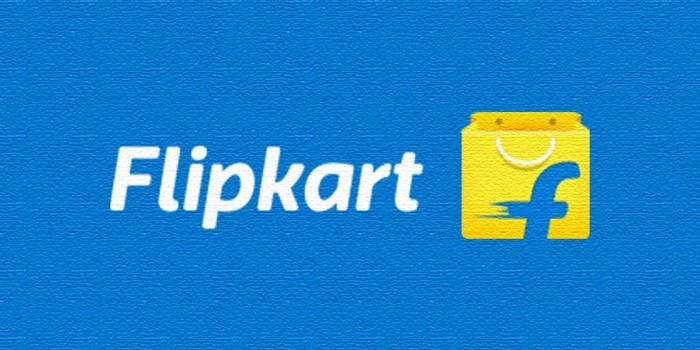
There is no doubt about the fact that Flipkart is one of the most amazing and useful online shopping sites for people these days. However, to have a better understanding of the company, people need to know about the business model that Flipkart has in the first place.
Flipkart is a site that uses the B2C or Business to Consumer business model for the success of the company.
That means the business can provide the best of the support to the customers who want to have it in the first place. With the help of Flipkart, the sellers will be able to sell their collections in the best way.
If there are any product collections that they have, then they will be able to provide these products to the people. They can provide some discounts on the products as well to make sure that people are attracted to buy the products that they have in line for them.
The customers then visit the website of Flipkart and have a look at the products that are available there to decide whether they want to buy it or not. After the product has been ordered, it will be shipped and delivered to the address of the customers.
The sellers always have an agreed and fixed price that is offered on the website.
This fixed price is set after deducting the basic commission that Flipkart gets from the sellers for the services that are provided to them in the first place.
This is one of the best models that are used by the company of Flipkart, and there is absolutely no doubt that people will definitely be able to understand the process more if they know the business model of the Flipkart company in the best way.
Customers targeted by Flipkart Business Model
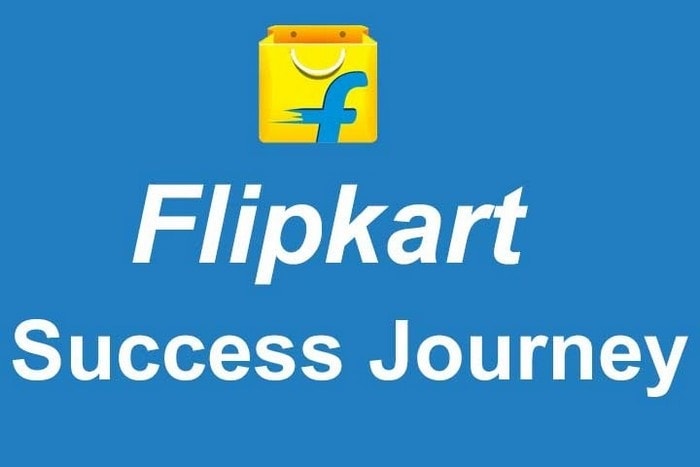
#1. Urban Buyers
Urban market is one of the most powerful audience bases of Flipkart, as it easily avails their products and services with personalized offers, discounts, and payment methods.
#2. Internet Users
Buyers who are online are also the key target of the business model of Flipkart. Via analytics, the company knows about the inclinations of these users and hence runs customized campaigns to generate conversions.
#3. Discount Seekers
All those buyers who prefer buying products at a discounted price are the prime target of Flipkart; the company comes with special offers, discounts, and coupons to help such buyers get the products at markdown cost.
#4. Customers looking for Ease of Shopping
In case you want the ease of shopping, you are also a target customer of Flipkart. Means those who want to fulfil all their requirements just by sitting at their homes, Flipkart serves them well even at the discounted prices.
#5. Buyers inclined towards specific products
People who do online searches for specific types of products are also the target base of Flipkart. Analytics help Flipkart to know about those searches and buyers. This way, the company showcases the ads to those customers on their browsers and devices to convert them as the buyer.
Now, as you are aware of the customers of Flipkart, the next key thing about the business model of Flipkart is its value propositions -
Value Propositions comprised by Business Model of Flipkart
- Product Launches related to Electronics, Home & Furniture, Baby & Kids, TVs & Appliances, Sports, Books & so on
- Personalized features such as Customer Account with Login & Signup, Selling services on Flipkart as a Seller, Advertising Opportunities, 24x 7 Customer Services, Software Application (Dual Interface), Flipkart Assured Badge
- Highly Convenient Services, Wide Product Range, Easy Delivery and Discount Offers
Channels of Business Model of Flipkart

Flipkart comprises a wide range of channels for effective channelization of its business model. Let us have a look at those here and now-
#1. Website
This includes official Flipkart site and Flipkart Plus along with Seller Program and Affiliate Programs that enable Flipkart to reach to its customers.
#2. Applications
Flipkart Online Shopping App and Flipkart Seller Hub are the parts of this channel.
#3. Social Media Platforms
Different social media platforms such as Facebook , Twitter , LinkedIn , Instagram , YouTube , Google + are used as channels.
Key Elements of Flipkart Business Model
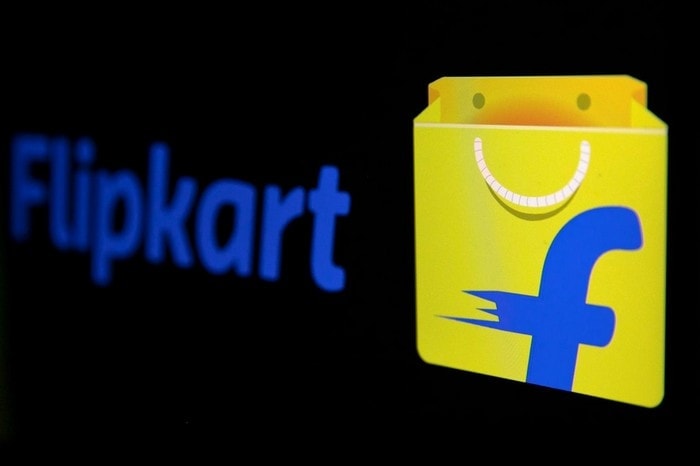
In the key elements, first come the partners that help in channelizing business model of Flipkart and they are-
- Authors and Publishers
- Different Subsidiaries such as Myntra, PhonePe, Jobong.com, LetsBuy, eBay .in and EKart
- Walmart that owns 81.3% of Flipkart
- Manufacturers, Sellers, and distributors of products
- Payment Partners
Next element that you need to understand here is the resources that help business model of Flipkart generate funds. Some of them are-
- Venture Capital Fund Partners such as Accel India, MIH (Naspers Group Sector), Tiger Global, ICONIQ Capital
- The immense flow of traffic around 100 million per day
- Payment Resources such as COD, Credit Card, Internet Banking Services, Payment Apps
Now, you should look upon the activities that the business model of Flipkart needs to channelize-
- Offering 24/7 customer service via phone, email, phone, and chat
- Ensuring a secure payment gateway
- Designing, developing and optimizing the Flipkart Platform
- Ensuring top-notch supply chain management
- The managing network of sellers
- Hiring, training and retaining the workforce
- Effective management of product catalogues
- Marketing , sales promotion activities and their role in deciding the pricing
- Offering different promotional offers and discounts as per different occasions
- Proper channelization of partnership with manufacturers and distributors
All these activities also play a key role in deciding the cost structure of Flipkart Business Model. Key parts of cost structure are-
- Warehouse management and deliver cost
- Technology and infrastructure support cost
- Workforce maintenance cost
- Advertising & Business Promotional Expenses
So, these were some of the key elements upon which the business model of Flipkart is based upon. Now, we will understand how Flipkart generates its revenues-
How Does Flipkart Make Money?
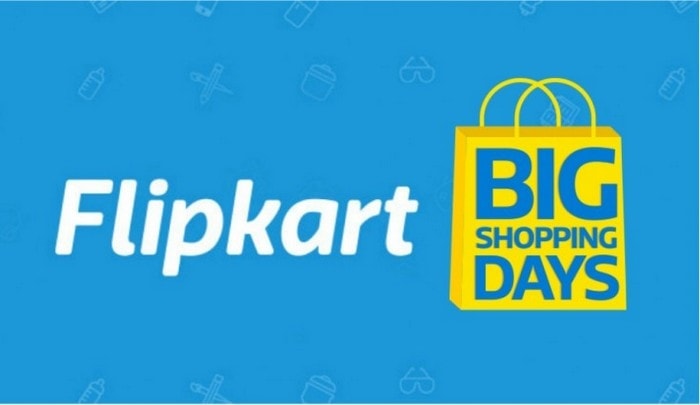
There are many different options that are provided to the customers through the help of which they will be able to buy and sell the products in the best way to the customers out there.
#1. Via Flipkart Website
There is a Flipkart website that they can use in order to list their products so that people can buy them. Also, there is a web application that is provided by the Flipkart Company as well.
The website and the web application are two of the most important aspects which play a great role in the generation of revenue for the company in the best way.
#2. Via Mobile Application & Social Media
Also, there is a mobile application which can be used by the customers for a fantastic experience of online shopping from a mobile phone.
Apart from that, Flipkart also uses the amazing social media websites for the promotion of the products, and there are affiliate-networks of the company as well such as websites, bloggers, coupon websites, review websites and so much more.
#3. Commission Structure
The commission that is charged by Flipkart is also one of the main reasons why the company is able to make so much money in the first place. The commission that is taken by the Flipkart Company from the users actually depends on the product and the sales-type that they tend to have all the time.
There are 5% to 20% of the taxes on the product and the discounts as well.
So, there is no doubt that the company is able to make a lot of money from product sales and the other forms of commission in the best way.
#4. Listing fee and Convenience Fee Options
Apart from that, the business model of Flipkart also derives revenue from some listing fee options and the convenience fee options provided, which is possibly another best way to generate additional revenues.
With the help of the amazing listing fees and convenience fees, the company is able to get some money from the sellers who want to list their products on the site and the application so that the people are able to see it when they are visiting the site on their online shopping times.
#5. Logistics and Shipping
There are some other sources of income as well in the business model of Flipkart, such as the logistics options. This is the amount that is collected from all the sellers for the shipping of their products in the best way.
The service is basically similar to the ones that are provided by the other online delivery companies in the best way. E-Kart is the online shipping service of Flipkart.
Not just that but digital media and ads are some of the most amazing ways with which the company of Flipkart can add some revenue to the profits in the best way. There are ads which are sold to the brands and the companies to get the profits.
Apart from that, the site of Myntra is another form of revenue generation for the company.
So, these are some of the details that one needs to know about the business model of Flipkart.
What do you think about the business model of Flipkart? Share your views in the comments below.
Liked this post? Check out the complete series on Business Models
Related posts:
- Business Model of Amway – How Amway Business makes money?
- Business Model Of Facebook – How Facebook Makes Money
- Business Model of eBay – How eBay Makes Money!
- Business Model of TCS – How TCS Makes Money?
- Business Model of Amazon and How Amazon Makes Money
- Business Model of Twitter & How Twitter Makes Money Explained
- Business Model of McDonald’s and How it Makes Money
- Business Model of Big Basket and How it Makes Money
- Business Model of Google Pay and How Google Pay Makes Money
- Business Model Of Byju’s – How Byju’s Makes Money?
About Hitesh Bhasin
Hitesh Bhasin is the CEO of Marketing91 and has over a decade of experience in the marketing field. He is an accomplished author of thousands of insightful articles, including in-depth analyses of brands and companies. Holding an MBA in Marketing, Hitesh manages several offline ventures, where he applies all the concepts of Marketing that he writes about.
All Knowledge Banks (Hub Pages)
- Marketing Hub
- Management Hub
- Marketing Strategy
- Advertising Hub
- Branding Hub
- Market Research
- Small Business Marketing
- Sales and Selling
- Marketing Careers
- Internet Marketing
- Business Model of Brands
- Marketing Mix of Brands
- Brand Competitors
- Strategy of Brands
- SWOT of Brands
- Customer Management
- Top 10 Lists
Leave a Reply Cancel reply
Your email address will not be published. Required fields are marked *
- About Marketing91
- Marketing91 Team
- Privacy Policy
- Cookie Policy
- Terms of Use
- Editorial Policy
WE WRITE ON
- Digital Marketing
- Human Resources
- Operations Management
- Marketing News
- Marketing mix's
- Competitors
End-to-end Case Study on Marketing Strategy of Flipkart and Advertising Campaigns
By Aditya Shastri
About flipkart.

Flipkart is an E-commerce website, founded by Sachin Bansal and Binny Bansal in 2007. When Flipkart was launched, initially the aim was to sell books before expanding into other product categories such as consumer electronics, fashion, home essentials & groceries, and lifestyle products. In March 2017, Flipkart held a 39.5% market share of India’s e-commerce industry. In August 2018, U.S.-based retail chain Walmart acquired an 81% controlling stake in Flipkart for US $ 16 billion, valuing it at $20 billion.
Flipkart is India’s answer to Amazon. Flipkart is one of the most visited E-Commerce Websites and just like Amazon, the company has rapidly become one of India’s original unicorns. The company is now owned by Walmart and is one of India’s huge success stories.
Let’s look at the marketing strategy of Flipkart.
Marketing Strategy of Flipkart
The marketing strategy of Flipkart focuses on every single touchpoint their customers are present. It uses the majority of its budget on various digital channels involving both paid and organic marketing. Moreover, since India has recently experienced digital transformation, the efforts of Flipkart are paying off.
Flipkart also invests intensely in celebrity endorsement and influencer marketing . India is crazy over Bollywood and Flipkart uses this to raise awareness about their brand and to market their services. Ranbir Kapoor, Alia Bhatt, Varun Dhawan, and Shraddha Kapoor have all been brand ambassadors who were predominantly featured in Flipkart’s commercials and digital marketing campaigns.
Let’s unveil the digital marketing strategy of Flipkart.
Flipkart is considered to be one of the best platforms for online shopping. Whether we talk about gadgets or apparel, Flipkart has always shown up their best quality service. Flipkart has mainly grown its business through a digital marketing strategy . Let’s discuss, What strategy do they follow? How do they convert their one-time customers to loyal customers? How does Flipkart manage to increase the number of its customers? This article will help in the analysis of the tools used by Flipkart in their Digital Marketing Strategy. IIDE , Google, & Coursera are a few digital marketing institutes among the top institutions to learn digital marketing .
Target audience
Flipkart targets anybody who surfs the internet and who does not have time for shopping. Though its target audience is scattered over various market segments as consumers from all demographic backgrounds can find products that appeal to their interests, 75% of its audience is between the age group of 16 – 55.
It lays focus on people seeking variety and who prefer to experience a hassle-free shopping approach from home. It tries to expand its services to every location in the country where deliveries are possible. The smart marketing strategy of Flipkart seizes the attention of its audience who hold the purchasing power, to influence that online shopping is better than traditional shopping.
Search Engine Optimization
Flipkart being the largest online retailer in India has worked immensely on optimizing its platform to rank on the search engine. Every time someone searches for a product, Flipkart appears among the top 2 results, and it is all possible because Flipkart has put a lot of effort into SEO.
As per Ubersuggest, a keyword tool by Neil Patel, Flipkart has monthly organic traffic of 3,90,246,762 and a strong domain authority of 90.
The domain has a total of 66,547,531 backlinks, These stats are really amazing.

The graph below shows the monthly search volume of Flipkart. As per the latest results, Flipkart had a total of 55.6 million searches, out of which 11.3 million were mobile searches and 44.3 million were desktop searches.

Ubersuggest gives an idea of keywords for which Flipkart is being searched over the internet. The graph below shows different keywords and their search volume.
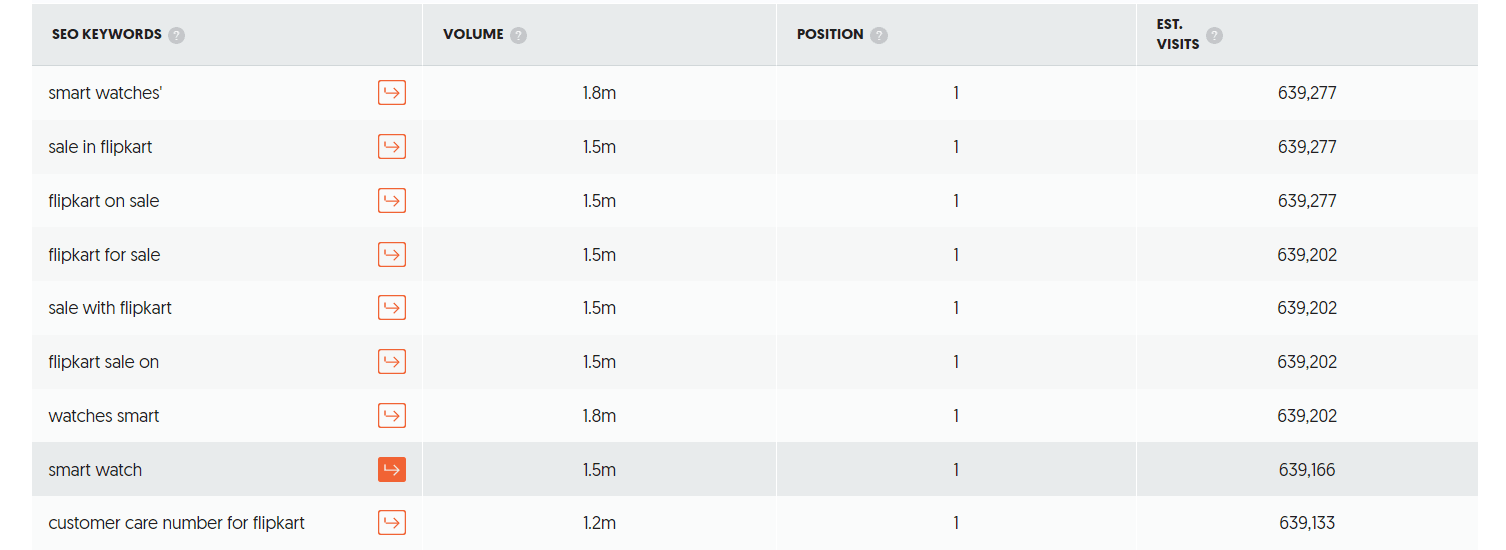
As you can see, smartwatches have a search volume of 1.8m which is followed by the Flipkart sale which has a volume of 1.5m. These are the top keywords that people search on the internet.
Keywords in URL
Flipkart checks the top searches of people, it then takes the top keywords and creates web page URLs for them. This is a very good marketing strategy for Flipkart to make sure its website ranks .
Below is the list of keywords for which Flipkart.com ranks.
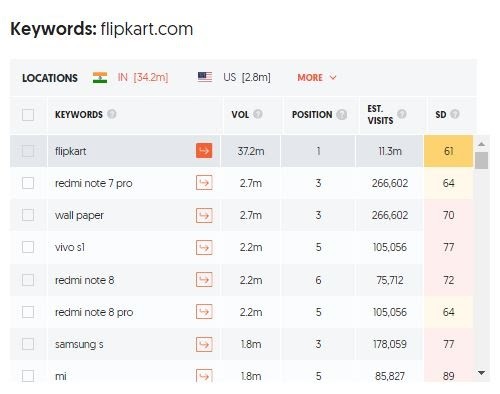
Backlinks of Flipkart
Flipkart gets backlinks from over 66 million unique domains, which is simply amazing. All these backlinks work as a backbone for Flipkart in ranking number 1 on the search engine. Ever wondered how backlinks help in search rankings? Read this blog on what are backlinks .

Backlinks for Flipkart have increased rapidly over time. The graph below shows how from December 2019 to August 2020, backlinks have grown from 73.3 million to 98.7 million.

Another important aspect of Search engine optimization is Site speed. Site speed is crucial to your SEO health. Every additional 0.5s it takes to load your site drastically increases the % of visitors that will leave your site.
Below you’ll see the time it took for Flipkart to load on desktop and mobile devices using a 4G connection speed.
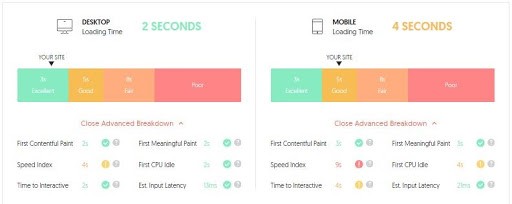
Keywords on the web pages

Keywords that include products’ names and phrases like ‘Best price’ tell the search engines that these pages have content related to these search queries.
Collaborations & Celebrity Marketing
Flipkart is known for its collaborations. It also invests heavily in star power and celebrity marketing. Flipkart keeps collaborating with various famous figures from time to time. One of the notable and more recent collaborations is with Ranbir Kapoor & Alia Bhatt on “#IndiaKaFashionCapital.”
Under this campaign, the company invites fashion enthusiasts from all over the country to upgrade their style with the latest trends from Flipkart. Via a meaningful media mix, using styled fashion quotient and targeted communication towards their consumers, Flipkart Fashion’s brand ambassadors, Ranbir and Alia, educate consumers about always being ahead in their style game by ‘Wearing The Next.’ The pair were seen in a variety of engaging and interactive formats, ranging from short digital content to traditional TVCs discussing the benefits of shopping on Flipkart Fashion.
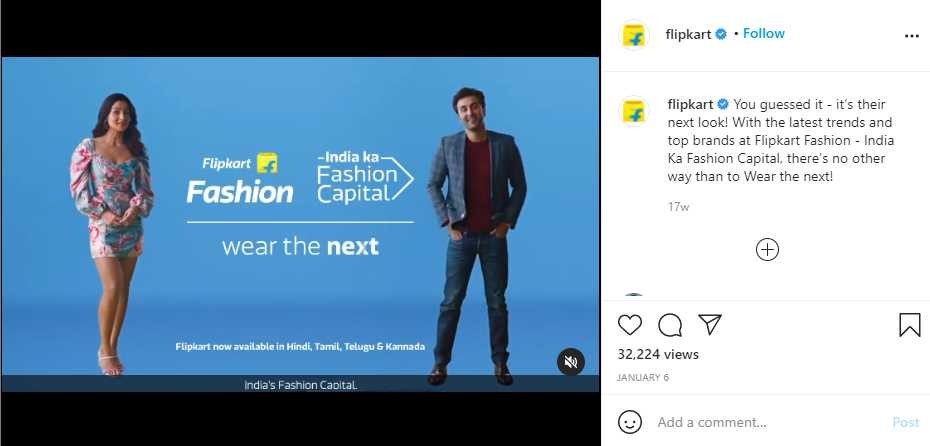
Social Media Marketing Strategy of Flipkart
Flipkart is very much active on all social media platforms. As of August 2020, Flipkart has –
-93,96,244 followers on Facebook,
-1.7 Million followers on Instagram,
-2.4 Million followers on Twitter.
When it comes to Instagram, Flipkart has several accounts for different things, like a proper account dedicated to Tech, Clothing, and others. When it comes to businesses, be it for a product or different services, the key highlight point for the customers is Feedback and Customer Reviews. Flipkart has given special attention to that by having a separate account that just focuses on Customer Stories named as FlipkartStories .
Twitter Strategy
You’ll be surprised to know that out of all the platforms Flipkart pays special attention to Twitter. Flipkart is known to follow a fixed pattern for communication for all the platforms but when it comes to Twitter, they keep running mini-campaigns from time to time like #SareeTwitter
Apart from fun campaigns, Flipkart has a 24*7 available Customer Support System on Twitter where they address complaints and queries of their customers. Next time you face a problem with Flipkart, you know what to do.
Youtube Marketing

Covid Marketing Strategy of Flipkart
The COVID-19 crisis has put everyone in a fix. During this time the demand for online services was high due to obvious reasons, so Flipkart along with other e-commerce platforms had to deliver products keeping their safety as well as their customers’ safety in mind.
To ensure the safety of their customers Flipkart started a no Contact Delivery process #FlipkartForIndia , where products will get delivered after proper sanitization and health & hygiene checking.
To appreciate and support the frontline warriors, Flipkart in collaboration with its parent company Walmart, donated medical supplies worth Rs 46 Cr to fight the battle against CoronaVirus in India. That’s not all to get the essentials delivered to its customers safely and as soon as possible, Flipkart partnered with Uber and Meru Cabs in various cities across the country. Along with all this Flipkart #SmartBuy also launched hand sanitizers and surgical masks to ensure there’s no shortage in this battle.
Flipkart didn’t do all these just for their Brand Promotion and that’s clear by the way they have promoted common people who were out on the road as support for the needy and the warrior on their Social Media Platform and labeled it as #FlipkartBrightSide. Flipkart shared stories of common people doing their bit, for example :
1. To aid the strenuous efforts taken by policemen in Kerala to enforce the lockdown, Anand and Sivan Macro offered them a tea break! The father-son duo set up a makeshift tea kiosk in their car, distributing nearly 200 cups of tea every day.
2. Renowned ophthalmologist Shibal Bhartiya in Delhi assembled a team of volunteers and has distributed over 2,000 packets of biscuits, 4,600kg of dal-chawal (uncooked), 2,000 soap cakes, and 500kg detergent to the needy.
Marketing Campaigns of Flipkart
Frequently bought together.
Flipkart loves to understand and study customer behaviour and keeping that in mind they have started a series of ‘Frequently Bought Together’. In this, Flipkart, based on customer behaviour and purchase pattern, shares the items which are frequently bought by the audience from the app. Check out the image below
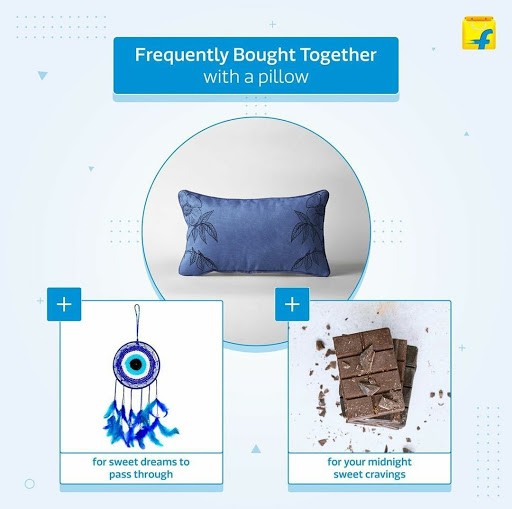
Don’t you think it’s a great marketing strategy of Flipkart to market products by having a psychological effect, where they tell you to opt for other products?
Flipkart Kidults
A discussion on the marketing strategy of Flipkart is incomplete without the mention of their campaign Kidults. It was launched way back in 2014 and it’s yet to end. Well, that itself speaks about the success of this campaign. Right? The reason behind such an impressive track record is the refreshing concept where Kids act like adults.
Flipkart launched a new campaign featuring actor Alia in the role of a ‘FlipGirl’ superhero to convey the ease of shopping and trust for customers. The campaign aimed to highlight the brand’s commitment to making premium brands accessible through faster delivery and establishing itself as the go-to destination for online shopping.
#MultiPurposePurchase
When it comes to merging two products or telling how to fully utilise a product, Flipkart is a master at it. Check this out

This is how you can fully utilize a slipper brought from Flipkart. Isn’t it an appealing and catchy way to market products?
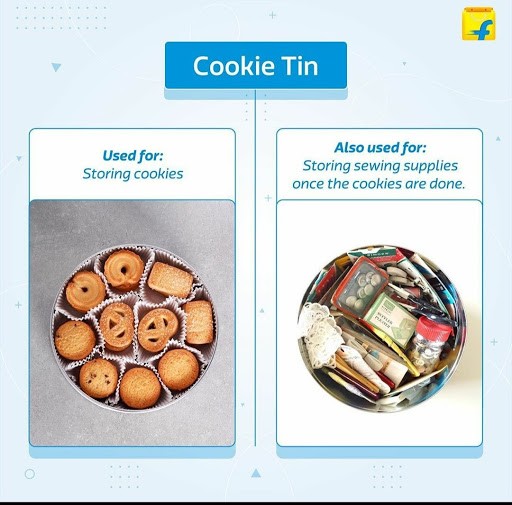
All Cookie lovers here would totally relate to this. We Indians have a thing for boxes especially the food boxes, we tend to keep them once empty and utilise it for different purposes. This is how simply Flipkart is connecting with the masses.
Special Occasions
The brand follows a Social Media Calendar and makes the most of the Special Days, right from universally celebrated occasions like Father’s Day, and Sleep Day to days of national importance like Gandhi Jayanti and Independence Day. Usually, e-commerce platforms like Flipkart and Amazon have special discounts and offers on such occasions, so these posts are not there to drive traffic but to maintain a social media presence and act as a reminder to shop.

Flipkart’s VR Campaign
We all are stepping into the world of artificial reality and virtual reality slowly and we have already seen the impact and use of filters by brands for Instagram Stories. Flipkart is always up and ready when it comes to adapting to new technologies. Flipkart discovered the right opportunity to make the most of VR technology by adding it to the Big Billion Sale Campaign. No doubt that the Big Billion Day campaign has massively contributed to Flipkart’s marketing success and they were able to attain the goal much more effectively with the advanced VR technology.
The campaign was launched when Full Moon Day was nearing as it is viewed auspiciously and closely associated with the festive calendar in India. Their ad campaign ran on days when there was no full moon, but Flipkart privileged its users to see a full moon shaded by clouds. Gamification prompted the users to blow into the microphone to move the clouds away revealing both the full moon and an exciting new offer. This campaign was like something never experienced before and it left the audience thrilled and excited, earning Flipkart 5 million views and a CTR of 2 %
Fun Engagement Activities
Flipkart keeps their audience engaged with different types of fun activities and with that being said they don’t forget to mix it up with something which is trending. For example, during this lockdown many things have gone viral and trended, one such thing was Dalgona Coffee, remember? This is what Flipkart did
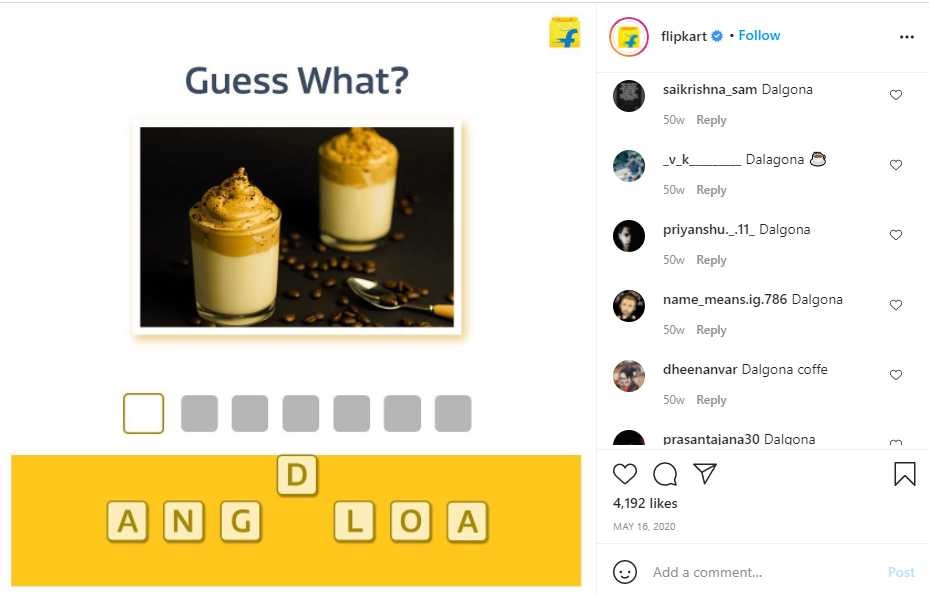
Apart from these, Flipkart is not behind when it comes to Current Affairs. Flipkart released this logo during the Pride Month

With months of lockdown and everyone in their house, there was a desperate need for some products, see what Flipkart had to say about it

During the lockdown, the online delivery rate was on the rise, but at the same time safety was a concern, considering that the brand delivered a perfect message for No-Contact Delivery.
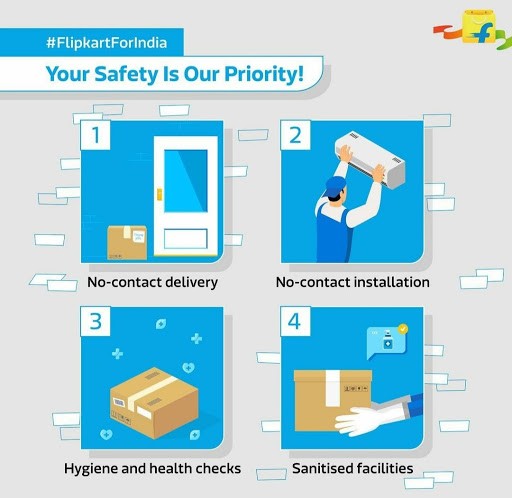
Paid Advertising by Flipkart
The marketing strategy of Flipkart also includes another important component which is paid advertising:
Google Adwords
When it comes to Search Ads, Google Adwords is the go-to option. Being an e-commerce platform, Search Ads on Google play a key role in both sales and bringing in traffic to the site. Today users just go on Google and search for the product and if you’re not in the top results, you’re missing out. Thus, Google Ads are a must. Flipkart runs display, search, and shop ads the most, by carefully studying and targeting the right set of keywords. Here’s an example of how Flipkart is running ads on Google for random searches and driving traffic and a potential customer.
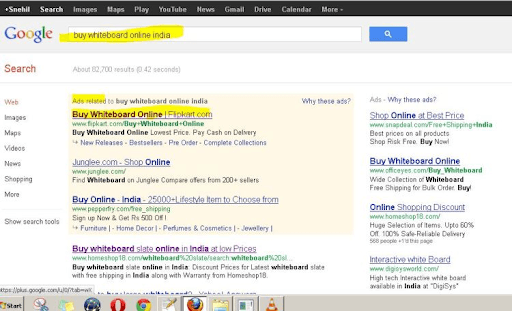
For E-Commerce platforms, Google Ads is a medium to drive attention toward their platform by appearing on the search results of other platforms. With Amazon giving neck-to-neck competition, getting your Google ad copy is crucial. Flipkart uses 3rd party platforms to run ads and advertise on different websites, majorly to remarket to those customers who add products to their carts or just wishlists. Once a user clicks on any of their Google ads, Flipkart re-targets them across social media platforms using the Facebook Pixel via ads.
Flipkart’s Affiliate Program
Affiliate marketing is performance-based marketing by which a person can earn rewards in the form of a commission for marketing another person’s or company’s products. Flipkart delegates the responsibility of marketing its products to third parties known as affiliates and shares a part of the profit on the sale of the products. Affiliate programs of e-commerce portals like Flipkart and Amazon are some of the legit ways to earn money online during this lockdown.
Flipkart portal offers almost everything needed by a commoner. From beauty to baby care products to fashion to electronics and beauty to baby care products, everything can be found on this online portal. All you need is decent traffic on your website or blog. You can then join Flipkart’s affiliate program and market a range of products in your niche. Flipkart offers one of the best affiliate marketing programs through which people are earning around Rs.25,000 to Rs. 80,000 per month. -15% of the product’s price. To know more about the commission percentage for each product category, you can go here .
Flipkart Affiliate Marketing Commission
Below we are mentioning a few product categories and their commission percentages:
- Books and e-learning (10%)
- Gold and silver coins (0.1%)
- School supplies and toys (10%)
- Baby care products (10%)
- Fragrances and Beauty products (10%)
- Household supplies (10%)
To know more about the commission percentage for each product category click here Affiliate programs are perfect for larger stores and eCommerce sites, and this is one of the highly successful marketing strategies of Flipkart.
Remarketing
Remarketing is any marketing and advertising strategy that re-establishes a connection with potential buyers after they visit the store’s website. Remarketing existed before the arrival of the Internet, however, its usage has shifted from offline to online and it is highly beneficial and inbound. Usually, visitors visit the online portals and leave the site without completing the purchase. Remarketing is done by displaying ads to such potential customers across the digital platforms urging them to convert.
Flipkart has a huge customer base that does window shopping and checkout for specifications for the products. Yet, not all products viewed are bought by the customers. certain products are even revisited by the customers several times after hours of viewing them. It indicates a strong intent to buy when customers leave products in the cart.
The survey says, out of 100 customers who shop online, 30 of the customers add products to the cart.
That’s 30% of customers who are interested in buying some product! That’s a huge number. However, only 3% of such customers buy the product at a later stage. Around 27% of such users leave those products just like that. Remarketing is employed for targeting such an audience via ads.
So be it billboards, tv commercials, or digital ads, Flipkart has always been on the front seat in developing marketing strategies around existing trends. Its smart yet emotionally woven ad campaigns leave a strong impression in the hearts of Indian audiences. Equally giant competitors might threaten Flipkart’s business but it will definitely continue to rule the E-commerce industry for decades to come. All this is because of the brilliant marketing strategy of Flipkart.
If you liked this case study, on the marketing strategy of Flipkart then do share it with your friends. Also, If you are interested in digital marketing or a student with an understanding of the digital world, you should check out Free Digital Marketing MasterClass by IIDE.
What are your thoughts on the marketing strategy of Flipkart? Please feel free to share in the comment section below. Thanks for reading!

Author's Note: My name is Aditya Shastri and I have written this case study with the help of my students from IIDE's online digital marketing courses in India . Practical assignments, case studies & simulations helped the students from this course present this analysis. Building on this practical approach, we are now introducing a new dimension for our online digital marketing course learners - the Campus Immersion Experience. If you found this case study helpful, please feel free to leave a comment below.
Aditya Shastri
Lead Trainer & Head of Learning & Development at IIDE
Leads the Learning & Development segment at IIDE. He is a Content Marketing Expert and has trained 6000+ students and working professionals on various topics of Digital Marketing. He has been a guest speaker at prominent colleges in India including IIMs...... [Read full bio]
I believe every business student and professional should read this insightful flipkart marketing strategy case study
Submit a Comment Cancel reply
Your email address will not be published. Required fields are marked *
Submit Comment
This site uses Akismet to reduce spam. Learn how your comment data is processed .
Related Posts
Full case study on the marketing strategy of acc.
by Aditya Shastri | Jul 31, 2024
Quick Read ACC Cement's marketing strategy focuses on innovative advertising, digital...
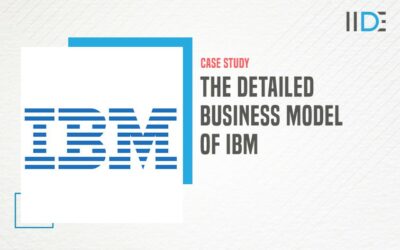
A Step-by-step guide on the Detailed Business Model Of IBM
Quick Read IBM's business model revolves around innovative digital marketing, diverse...
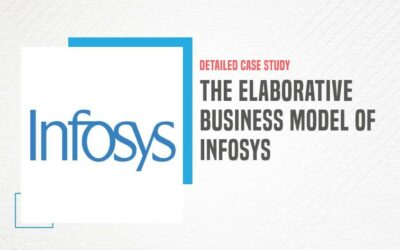
Elaborative Business Model of Infosys – Explained
by Aditya Shastri | Jul 30, 2024
Quick Read The Infosys business model is centred on IT services and consulting. This...
" * " indicates required fields
I’m Interested in This Masterclass
By providing your contact details, you agree to our Terms of Use & Privacy Policy
- Harvard Business School →
- Faculty & Research →
- November 2015 (Revised April 2018)
- HBS Case Collection
Flipkart (A): Transitioning to a Marketplace Model
- Format: Print
- | Language: English
- | Pages: 15
About The Authors
Das Narayandas
Sunil Gupta
Related work.
- Faculty Research
Flipkart: Transitioning to a Marketplace Model
Flipkart (b): the ongoing battle for india's e-commerce market.
- Flipkart: Transitioning to a Marketplace Model By: Sunil Gupta and Das Narayandas
- Flipkart (B): The Ongoing Battle for India's E-Commerce Market By: Sunil Gupta, Das Narayandas and Rachna Tahilyani
- Flipkart (A): Transitioning to a Marketplace Model By: Das Narayandas, Sunil Gupta and Rachna Tahilyani
By using our website, you consent to the use of cookies and other tracking technologies as described in our privacy policy.
I Agree Close

- Switch skin
Inside the Success Story of Flipkart – A Case Study in Indian E-Commerce Dominance

The emergence of Flipkart as a powerhouse in the Indian e-commerce landscape is a remarkable tale of innovation and entrepreneurial spirit . Founded in 2007 by Sachin Bansal and Binny Bansal , the company quickly rose to prominence, challenging traditional retail models and disrupting the market with its online platform. Over the years, Flipkart has not only dominated the Indian e-commerce scene but has also revolutionized the way people shop in the country.
Table of Contents

The Genesis of Flipkart
Founding story.
A quintimperative rags-to-riches tale, Flipkart’s journey began in 2007, when two former Amazon employees, Sachin Bansal and Binny Bansal, pooled their savings to kickstart an online bookstore. What started out as a modest venture operating out of an apartment in Bengaluru would eventually evolve into India’s leading e-commerce platform.
Early Challenges and Breakthroughs
Story Despite facing fierce competition from established players and logistical hurdles such as unreliable courier services and internet connectivity issues, Flipkart persevered. The turning point came in 2010 when they introduced ‘Cash on Delivery’ as a payment option, revolutionizing e-commerce in India.
Flipkart’s ability to adapt to the Indian market’s unique demands and infrastructure challenges set them apart. They launched innovative marketing campaigns, built a robust supply chain network, and prioritized customer service, setting new benchmarks for the industry .
Business Model Evolution
From online bookstore to e-commerce giant.
From its humble beginnings as an online bookstore in 2007, Flipkart quickly evolved into a major player in the Indian e-commerce space. It started by offering a platform for buying books, eventually expanding its product range to include electronics, fashion, home goods, and more. This shift in focus allowed Flipkart to cater to a wider audience and tap into the growing e-commerce market in India.
Innovation and Adaptation in Business Strategies
Business innovation and adaptability have been key factors in Flipkart’s success story. In the fiercely competitive e-commerce landscape, Flipkart has distinguished itself by constantly innovating and adapting its business strategies to meet changing consumer demands and market trends. By introducing features such as cash on delivery, easy returns, and personalized recommendations, Flipkart has been able to stay ahead of the curve and retain its position as a dominant player in the Indian e-commerce industry.
Funding and Financial Growth
Many e-commerce success stories can be attributed to the funding and financial strategies adopted by the companies. In the case of Flipkart, its journey from a small online bookstore to India’s leading e-commerce giant is no exception. For a detailed account of Flipkart’s funding journey, you can refer to Flipkart’s Success Story: From a Startup to India’s Leading E-Commerce Platform .
Seed Funding and Venture Capital Infusion
Seed funding played a crucial role in Flipkart’s initial growth. The company received its first investment from Ashish Gupta and a few other angel investors in 2009. This seed funding helped Flipkart establish itself in the Indian e-commerce market. Subsequently, Flipkart attracted venture capitalists like Tiger Global and Accel Partners, who infused capital to fuel its expansion and technological advancements.
Financial Milestones and IPO Speculations
One of the most significant milestones in Flipkart’s financial journey was when it crossed the billion-dollar valuation mark, earning the coveted unicorn status. This achievement solidified Flipkart’s position as a key player in the Indian e-commerce industry. As Flipkart continued to grow and diversify its offerings, speculations about an IPO started gaining momentum. While there is no official confirmation yet, industry experts believe that an IPO could be on the horizon for Flipkart, marking a new chapter in its financial growth story.
Acquisition and Expansion
Major acquisitions and their impact.
On the road to success, Flipkart has strategically executed several major acquisitions that have played a crucial role in its dominance in the Indian e-commerce market. One of the most significant acquisitions was the purchase of Myntra, a prominent online fashion retailer in 2014. This move not only allowed Flipkart to tap into the lucrative fashion segment but also helped them gain a loyal customer base and talented team.
Horizontal and Vertical Expansion Tactics
With a clear vision for growth, Flipkart has adopted both horizontal and vertical expansion tactics to strengthen its market position. Horizontally, the company has diversified its product offerings by venturing into new categories such as electronics, home appliances, and groceries. Vertically, Flipkart has focused on expanding its supply chain and logistics network to ensure efficient delivery of goods. This dual approach has not only broadened Flipkart’s customer base but also enhanced its operational capabilities.
Understanding the importance of strategic expansion, Flipkart has established partnerships with various brands and sellers to enhance its product range and availability. By leveraging its strong distribution network, Flipkart has been able to reach customers in even the most remote areas of India. This has not only increased its customer reach but also solidified its position as a market leader in the Indian e-commerce industry.
Flipkart’s Technological Edge
Once again, exploring the success story of Flipkart unveils the significance of technological innovation in shaping the trajectory of e-commerce dominance. A crucial milestone in this journey was Walmart’s strategic acquisition of Flipkart, indicating the emerging paradigm of Indian e-commerce in the global arena. For further insights on this development, refer to Walmart’s Acquisition of Flipkart: Emerging Paradigm of the… .
E-Commerce Technology and Platform Development
An integral component of Flipkart’s success lies in its relentless focus on e-commerce technology and platform development. The company has consistently invested in upgrading its technological infrastructure to enhance user experience, streamline operations, and stay ahead of the competition.
By leveraging cutting-edge technologies, Flipkart has managed to build a robust platform that caters to millions of customers, offering a seamless shopping experience across various categories.
Leveraging Data and AI for Market Advantage
Flipkart’s adept use of data analytics and artificial intelligence (AI) has been a game-changer in the e-commerce landscape. By harnessing the power of data,
Flipkart gains valuable insights into consumer behavior, preferences, and trends, enabling personalized recommendations and targeted marketing strategies.
Leveraging AI algorithms, Flipkart optimizes operations, from inventory management to logistics, leading to efficiency gains and cost savings. The company’s data-driven approach has not only boosted sales and customer loyalty but also positioned Flipkart as a trailblazer in online retail.
Challenges and Controversies
Competition from national and international players.
All new companies face their fair share of challenges, and for Flipkart, competition has been one of the biggest hurdles. From the early days of Indian e-commerce, Flipkart had to contend with local players like Snapdeal and Paytm, who were also vying for a piece of the market. As the industry grew, international giants like Amazon entered the scene, intensifying the competition further. This led to price wars, aggressive marketing strategies, and a constant battle for market share. Despite facing stiff competition, Flipkart managed to hold its ground and secure its position as a market leader.
Legal Hurdles and Regulatory Challenges
With the rapid growth of the e-commerce sector in India, legal and regulatory challenges became a common theme for companies like Flipkart. From issues related to FDI regulations to disputes over pricing strategies, Flipkart found itself entangled in a web of legal proceedings. Adhering to the ever-changing laws and regulations while maintaining a competitive edge was a delicate balancing act for the company. Despite these challenges, Flipkart strategically navigated the legal landscape and continued to innovate in the industry.
The Flipkart Effect on Indian E-Commerce
Influence on retail and consumer behavior.
Indian e-commerce has experienced a seismic shift with the advent of Flipkart. The platform not only revolutionized the way Indians shopped online but also altered their entire buying behavior. Flipkart’s introduction of various sales events such as ‘Big Billion Days’ and innovative marketing strategies like cash-on-delivery options transformed the perception of online shopping in a country where traditional retail dominated. Consumers became accustomed to the convenience of doorstep delivery, vast product choices, and attractive discounts, setting new standards for the e-commerce industry in India.
Contributions to the Indian Economy and Employment
Influencing both the digital landscape and economic growth, Flipkart has played a crucial role in contributing to the Indian economy and generating employment opportunities. The company’s success has paved the way for numerous small businesses and sellers to thrive on its platform, thus fostering entrepreneurship and economic development. The expansion of warehouses, logistics, and support services due to Flipkart’s operations has created a ripple effect, boosting ancillary industries and providing job opportunities across various sectors.
Flipkart’s commitment to empowering local businesses and artisans through initiatives like ‘Flipkart Samarth’ has further solidified its positive impact on the Indian economy. By providing a platform for small sellers to reach a wider audience and scale their businesses, Flipkart has not only contributed to their growth but has also enhanced the overall economic inclusivity of the country.
The Future of Flipkart
Despite the remarkable success outlined in The Success Story of Flipkart , it is crucial for the e-commerce giant to stay ahead of the curve and anticipate the rapidly evolving industry trends. To maintain its dominance in the Indian market, Flipkart needs to adapt to emerging trends and devise future strategies that set it apart from its competitors.
Emerging Trends and Future Strategies
The e-commerce landscape in India is continually evolving, with trends such as the rise of mobile commerce, increased personalization through data analytics, and the potential for augmented reality in the shopping experience. Flipkart must embrace these trends by investing in mobile technology, leveraging data analytics for tailored consumer experiences, and exploring innovative shopping interfaces like augmented reality. Embracing these trends will not only enhance user engagement but also increase customer loyalty and retention.
Predictions for Flipkart and Indian E-Commerce
One of the key predictions for Flipkart and the Indian e-commerce sector is the continued growth of the market. With an expanding internet user base and increasing consumer trust in online platforms, the e-commerce industry in India is poised for significant growth. Flipkart, with its established brand and infrastructure, is well-positioned to capitalize on this growth by expanding its product offerings, enhancing its logistics capabilities, and solidifying its presence in tier 2 and tier 3 cities.
Strategies : It is crucial for Flipkart to stay updated with emerging trends, invest in mobile technology and data analytics, and explore innovative technologies like augmented reality. By focusing on these strategies, Flipkart can maintain its competitive edge and secure its position as a dominant force in the Indian e-commerce sector.
Hence, the success story of Flipkart exemplifies the rise of Indian e-commerce giants and their dominance in the market. Through innovative strategies, customer-centric approach, and adaptability to changing market trends, Flipkart has solidified its position as a market leader in the e-commerce sector in India. The company’s strategic partnerships, focus on quality products, and commitment to customer satisfaction have contributed to its remarkable growth and success.
As the e-commerce landscape in India continues to evolve, Flipkart serves as a case study for aspiring entrepreneurs and businesses looking to establish a strong presence in the market. By understanding and implementing the key factors that have led to Flipkart’s success, other players in the industry can learn valuable lessons on how to thrive in the competitive e-commerce sector. Flipkart’s journey from a small online bookstore to a multi-billion dollar e-commerce giant showcases the immense potential for growth and success in the Indian market for those who are willing to innovate, adapt, and cater to the needs of consumers.

Share this:
- Click to share on Twitter (Opens in new window)
- Click to share on Facebook (Opens in new window)
- Click to share on LinkedIn (Opens in new window)
- Click to share on WhatsApp (Opens in new window)
- Click to share on Telegram (Opens in new window)

Business line
Why the novel set up ether etfs could per chance per chance additionally ‘be a success’ despite recent weakness, the psychology of leadership – understanding the minds of successful indian business leaders like narayana murthy, sustainable success – case studies of businesses like itc prioritizing environmental and social responsibility, lessons from failure – analyzing case studies of businesses that bounced back like spicejet, strategic success – case studies of businesses like reliance industries with sustainable growth models, the art of strategy – how successful businesses stay ahead in a competitive landscape like mahindra & mahindra, from startup to success – 5 entrepreneurs share their journeys, how these entrepreneurs overcame challenges to achieve success, learn the strategies behind 10 remarkable business success stories, behind the scenes – the keys to success for entrepreneurial leaders, breaking - the latest startup news roundup, the incredible success journey of india's top e-commerce startups.

Related Articles

Urban Mobility Redefined – Case Study of Ola's Ride-Hailing Success

Revolutionizing Real Estate – Case Study of NoBroker's Online Property Marketplace

Tech for Good – Case Study of UrbanClap's Impact on Service Sector

Gandhi Jayanti – Famous Quotes On Mahatma Gandhi
EDITORIAL BOARD
- INSTRUCTION TO AUTHOR
- Current Issue
- February 2024
- January 2024
- December 2023
- November, 2023
- October 2023
- September 2023
- August 2023
- February 2023
- January 2023
- December 2022
- November 2022
- October 2022
- September 2022
- August 2022
- February 2022
- January 2022
- December 2021
- November, 2021
- October, 2021
- September, 2021
- August, 2021
- February 2021
- January 2021
- CALL FOR PAPERS 2022
- Certificate
- Reviewers Form
- Indexing & Abstracting
- Editorial Board
- Submit Manuscript
- Instruction to Author
- Past Issues
- Call for papers/July 2024
- Ethics and Malpractice
- Conflict of Interest Statement
- Statement of Informed Consent
- Final Proof Correction and Submission
- Publication Ethics
- Peer review process
- Cover images - June - 2024
- Quick Response - Contact Us
CERTIFICATE
Author information.
- Copyright Form
- Join Editor & Peer Reviewers
- Paper Submission
- Impact Factor
- Policy of Screening
IMPACT FACTOR 2021
Subject area.
- Life Sciences / Biology
- Architecture / Building Management
- Asian Studies
- Business & Management
- Computer Science
- Economics & Finance
- Engineering / Acoustics
- Environmental Science
- Agricultural Sciences
- Pharmaceutical Sciences
- General Sciences
- Materials Science
- Mathematics
- Nanotechnology & Nanoscience
- Nonlinear Science
- Chaos & Dynamical Systems
- Social Sciences & Humanities
Why Us? >>
- Open Access
- Peer Reviewed
- Rapid Publication
- Life time hosting
- Free promotion service
- Free indexing service
- More citations
- Search engine friendly
Business model of flipkart india – a case study
Research in the field of e-commerce have become a dynamic study area over the past few decades and is likely to become even more so as the importance of online trade is rapidly gaining momentum. Therefore understanding e-commerce will be viewed as increasingly important. India has been regarded as the youngest country in the world by the UN as it has the world’s largest youth population where more than 365 billion people are between the age group 10 and 24 years. This clearly indicates that the fate of the country lies in the hands of its Youth. This case aims at examining the business model of Flipkart which has specially been designed keeping the youth in mind.
CALL FOR PAPERS
Online paypal payment, ijmce recommendation, monthly archive.
- November 2023
Advantages of IJCR
- Rapid Publishing
- Professional publishing practices
- Indexing in leading database
- High level of citation
- High Qualitiy reader base
- High level author suport
Plagiarism Detection
IJCR is following an instant policy on rejection those received papers with plagiarism rate of more than 20% . So, All of authors and contributors must check their papers before submission to making assurance of following our anti-plagiarism policies.


Case Study Flipkart (A): Transitioning to a Marketplace Model
- Dr. Kiran Kumar Thoti
- Ahmad Zaim Bin Mohd Alui
- Ong Zu Qian
Conducted case study was attempted towards examining the misperception circulating current e-tailing marketplace concerning misinformation of the platform’s existing product. Reviewing of surfaced product quality challenge further uncovered related issues from the aspect of unhealthy price competition within the Indian marketplace, discrepancy in socioeconomic factors towards proliferation of current e-commerce practice and organizational ability in balancing sales growth to profit gain. Earlier academic studies and theoretical groundworks were reviewed and revisited to analyze, further uncover potential alternatives targeting resolutions of surfaced issues. Fabricated knowledge was then compared against viability of the current case in achieving compromised decisions that benefit the forthcoming organizational practice. Flipkart is an Indian-based e-tailing organization which emphasized a revolutionary transformation to a comprehensive marketplace model company. From its humble beginning as an online book selling site, the virtual platform has grown into a dominating player within India’s domestic e-commerce market. The company has prided itself for offering of multiple product categories from a huge pool of domestic and international sellers at affordable prices and admirable service quality. Such aggregated performance, alongside continuous acquisition of promising brands, administrating of reliable sellers and acceptance of external advertising further secured the company with an extensive amount of foreign investment and local clientele. Its established logistic network subsequently factored proficient accessibility and reachability of the online consumeristic environment. Conducted inspection revealed over-emphasizing of price-based competition as Flipkart’s utmost severe shortcoming in ensuring a positive profit margin. The organization’s focus on price-cut and advanced deals has displayed an immense negligence on profound marketing strategy and quality maintenance of retailed products. A prospective outlook centering increase in vendors to cater an expanding marketplace has merely promised constructive revenue at potential deficit in actual return-of-investment (ROI). Direct competition without a sturdy market standing would be highly detrimental to existing players in the Indian e-tailing industry. Recommendations particular recognized a centralized approach to market rivalry by exploitation of core competencies and competitive advantage. A feint to the spiraling price war sees Flipkart’s shifted focus to both superficial product handling, market targeting and customer servicing. Investment towards advanced infrastructure for purposes of inventory management and freight network would ultimately act as necessary foundations to organizational preeminence by segmented market and sole distribution of other internationally renowned brands.
Članak, Z.I. (2018). Market Segmentation Analysis and Visualization Using K-Mode Clustering Algorithm for E-Commerce Business. Journal of computing and information technology, 26(1), 57-68.
Alrumiah, S.S. & Hadwan, M. (2021). Implementing Big Data Analytics in E-Commerce: Vendor and Customer View. IEEE Access, 9, 37281-37286. DOI: 10.1109/ACCESS.2021.3063615.
Arora, P. & Narula, S. (2018). Linkages between Service Quality, Customer Satisfaction and Customer Loyalty: A Literature Review. IUP Journal of Marketing Management, 17(4), 30-53.
Barney, J.B. (1986). Organizational Culture: Can It Be a Source of Sustained Competitive Advantage?. Academy of Management Review, 11, 656-665.
Bhosale, V.S., Raverkar, D.P., & Sable, D. (2020). An Analysis cum Study on Impact of E-commerce on India’s Commerce. International Journal of Advance and Innovative Research, 7(1), 32-34.
Cummings, T.G. & Worley, C.G. (2015). Organizational Development and Change (10th ed.). p.28. USA: Cengage Learning.
Das, S.S. (2020). Study of Inventory Techniques in E-commerce Grocery to Minimize Out of Stock and Increase Customer Shopping Experience. International Journal of Management, 11(9), 15-28.
DeWitt, T., Nguyen, D.T., & Marshall, R. (2008). Exploring Customer Loyalty Following Service Recovery: The Mediating Effects of Trust and Emotions. Journal of Service Research, 10(3), 269-281.
Drazdik Jr., A. (2020). Inventory Management: Actuary, Quality, and Regulatory Conditions. DOI: http://dx.doi.org/10.2139/ssrn.3700159
Farnham, P.G. (2014). Economics for Managers (3rd ed.). p.38. Edinburgh Gate Harlow: Pearson.
Feng, T. & Wang, X. (2021). Research on Supply Chain Integration and Optimization of Live E-commerce. Journal of Physics: Conference Series, 1827(1), 012212. DOI: 10.1088/1742-6596/1827/1/012212
Hendra, Rini, E.S., Ginting, P., & Sembiring, B.K.F. (2017). Impact of eCommerce service quality, recovery service quality, and satisfaction in Indonesia. 2017 International Conference on Sustainable Information Engineering and Technology (SIET), 35-40. DOI: 10.1109/SIET.2017.8304105.
Heriyati, P. & Budharani, A. (2018). How Price Perception and Satisfaction Influence Online Repurchase Intention. Pertanika Journal: Social Sciences & Humanities, 26(T), 9-17.
Hoe, L.C. & Mansori, S. (2018). The Effects of Product Quality on Customer Satisfaction and Loyalty: Evidence from Malaysian Engineering Industry. International Journal of Industrial Marketing, 3(1), 20-35.
Iglesias, O., Markovic, S., & Rialp, J. (2019). How does sensory brand experience influence brand equity? Considering the roles of customer satisfaction, customer affective commitment, and employee empathy. Journal of Business Research, 96, 343-354.
IndianOnlineSeller.com. (2022). Marketplace or Inventory-Led, which ecommerce model works best?. Retrieved from: https://indianonlineseller.com/2016/02/marketplace-or-inventory-led-which-ecommerce-model-works-best
Islami, X., Topuzovska, M., Drakulevski, L., & Popovska, M.B. (2020). Does Differentiation Strategy Model Matter? Designation of Organizational Performance using Differentiation Strategy Instruments – An Empirical Analysis. Verslas: teorija ir praktika, 21(1), 158-177.
Kara, A. (2020). E-Tailer Success Factors: an Investigation of the Relationship between Resources, Competitiveness and Performance. Turkish Studies – Economics, Finance, Politics, 15(1), 253-265.
Kim, Y. & Krishnan, R. (2015). On Product-Level Uncertainty and Online Purchase Behavior: An Empirical Analysis. Management Science, 61(10), 4-8.
Lin, Y., Luo, J., Zhou, L., Ieromonachou, P., Huang, L., Cai, S., & Ma, S. (2014). The impacts of service quality and customer satisfaction in the e-commerce context. 2014 11th International Conference on Service Systems and Service Management (ICSSSM), 1-6. DOI: 10.1109/ICSSSM.2014.6874093
Liu, X. (2019). Evolution and simulation analysis of co-opetition behavior of E-business internet platform based on evolutionary game theory. Cluster Computing, 22(1), 10241–10250. DOI: https://doi.org/10.1007/s10586-017-1265-x
Liu, Z., Guo, H., Zhao, Y., Hu, B. (2022). Optimal pricing decision of composite service offered by network providers in E-commerce environment. Electronic Commerce Research, 22(4), 177-193. DOI: https://doi.org/10.1007/s10660-021-09487-8
Mirabi, V., Akbariyeh, H., & Tahmasebifard, H. (2015). A Study of Factors Affecting on Customers Purchase Intention Case Study: the Agencies of Bono Brand Tile in Tehran. Journal of Multidisciplinary Engineering Science and Technology (JMEST), 2(1), 267-273.
Mu, J. & Zhang, J.Z. (2021). Seller marketing capability, brand reputation, and consumer journeys on e-commerce platforms. Journal of the Academy of Marketing Science, 49, 994-1020. DOI: https://doi.org/10.1007/s11747-021-00773-3
Paquet-Clouston, M., Décary-Hétu, D., & Morselli, C. (2018). Assessing market competition and vendors’ size and scope on AlphaBay. International Journal of Drug Policy, 54, 87-98.
Pi, S. & Wang, Y. (2020). An E-Tailer’s Operational Strategy under Different Supply Chain Structures. Sustainability, 12(5), 2141. DOI: https://doi.org/10.3390/su12052141
Riquelme, I.P., Román, S., Cuestas, P.J., & Iacobucci, D. (2019). The Dark Side of Good Reputation and Loyalty in Online Retailing: When Trust Leads to Retaliation through Price Unfairness. Journal of Interactive Marketing, 47, 35-52.
Rumelt, R.P. (1984) Towards a Strategic Theory of the Firm. Competitive Strategic Management, 26, 556-570.
Sanyala, S. & Hisamb, M.W. (2019). Factors Affecting Customer Satisfaction with Ecommerce Websites - An Omani Perspective. 2019 International Conference on Digitization (ICD), 232-236, DOI: 10.1109/ICD47981.2019.9105780.
Sasmoko, S., Abdinagoro, S.B., & Bandur, A. (2022). Role of E-commerce Maturity and E-commerce Adoption towards E-commerce Performance: An Evidence from Creative Industry in Indonesia. International Journal of eBusiness and eGovernment Studies (IJEBEG), 14(1), 150-167.
Shari, N.S.M. & Shamsudin, M.F. (2020). Can Game Theory Solve Marketing Problems?. Journal of Postgraduate Current Business Research, 5(1). Retrieved from: http://www.abrn.asia/ojs/index.php/jpcbr/article/view/62
Titiyal, R., Bhattacharya, S., & Thakkar, J.J. (2020). E-fulfillment performance evaluation for an e-tailer: a DANP approach. International Journal of Productivity and Performance Management, 69(4), 741-773. DOI: https://doi.org/10.1108/IJPPM-12-2018-0459
von Neumann, J., & Morgenstern, O. (1944). The Theory of Games and Economic Behavior. Princeton: Princeton University Press.
Wang, C.-N., Dang, T.-T., Nguyen, N.-A.-T., & Le, T.-T.-H. (2020). Supporting Better Decision-Making: A Combined Grey Model and Data Envelopment Analysis for Efficiency Evaluation in E-Commerce Marketplaces. Sustainability, 12(24), 10385. DOI: https://doi.org/10.3390/su122410385
Wang, X. & Wang, H. (2019). A Study on Sustaining Corporate Innovation with E-Commerce in China. Sustainability, 11(23), 6604. DOI: https://doi.org/10.3390/su11236604
Wang, Y.S., Lin, S.j., Li, C.R. et al. Developing and validating a physical product e-tailing systems success model. Information Technology Management, 19(4), 245-257 (2018). DOI: https://doi.org/10.1007/s10799-017-0286-8
Wang, Y.-S., Wu, S.-C., Lin, H.-H., & Wang, Y.-Y. (2011). The relationship of service failure severity, service recovery justice and perceived switching costs with customer loyalty in the context of e-tailing. International Journal of Information Management, 31(4), 350-359.
Wernerfelt, B. (1984). A resource-based view of the firm. Strategic Management Journal, 5(2), 171-180.
Williamson O. E. (1979). Transaction-cost economics: The governance of contractual relations. Journal of Law and Economics, 22(2), 233-261.
Yu, M., Liu, F., Lee, J., & Soutar, G. (2018). The influence of negative publicity on brand equity: attribution, image, attitude and purchase intention. Journal of Product & Brand Management, 27(4), 440-451. DOI: https://doi.org/10.1108/JPBM-01-2017-1396
- Requires Subscription or Fee Pdf (USD 30)
How to Cite
- Endnote/Zotero/Mendeley (RIS)
Current Issue
- NJCBMR Scope
- Call For paper
- NJCBMR Indexing
- Double Blind Peer Review
- Plagiarism Policy
- Open Access Statement
- Authorship Criteria
- Article Withdrawl Policy
- Journal's Instructions
- Digital Archiving Policy
- NJCBMR Key Words
- Copyright Form
- Mode of Payment
- Manuscript Submission Checklist
- Camera Ready Format
- Publication Services
- Publication process
Important Links
Top Marketing Journals
Information
- For Readers
- For Authors
- For Librarians
Make a Submission
Subscription.
Login to access subscriber-only resources.
- Terms & Condition
- Copyright Claims
- Publishing Ethics
- Privacy Statement


COMMENTS
The business model of Flipkart reigns supreme in India's e-commerce world, holding a whopping 48% market share. This means almost half of all online shopping in India happens on Flipkart. According to a report published by Alliance Bernstein, a global investment management & research firm, the number of people shopping on Flipkart is ...
In 2018, Walmart acquired a 77% stake in Flipkart for approximately $16 billion. This deal valued the 11-year-old Indian e-commerce firm at $20.8 billion. Immediate Impact. The acquisition provided SoftBank Vision Fund with a profitable exit, as they had previously invested heavily in Flipkart.
Flipkart Business Model. Flipkart's business model can be broken down into the following components: Online Marketplace: Flipkart's online marketplace allows sellers to list their products and connect with millions of customers across India. Sellers can list their products on the platform, and buyers can purchase those products through Flipkart ...
Flipkart, an e-commerce company was founded in the year 2007, by Mr Sachin Bansal and Binny Bansal. Both were alumni of the Indian Institute of Technology, Delhi. They had been working for Amazon earlier. With a desire to start something new and of their own, they launched Flipkart with a capital of Rs. 4 lakhs.
In July 2020, Walmart led another startup investment round for $1.2 billion, which raised Flipkart's valuation to $24.9 billion. The US retailer owns over 90% of Flipkart for $16 bn; it invested in 2018. In September 2020, Walmart invested $560 million in Flipkart as part of the $1.2 billion investment round. [ 1]
Business model of Flipkart consisted of sourcing of goods from manufacturers, selling them to a host of third-party sellers, who, in turn, offered them to shoppers. Flipkart's role was in providing the technology platform and providing the logistics services; for these, Flipkart charged commission on every sale through the platform.
1. Customer-Centric Approach. One of the fundamental pillars of Flipkart's business model is its unwavering commitment to customer satisfaction. The company understands that success in e-commerce hinges on building trust and delivering exceptional service to customers. To achieve this, Flipkart has invested heavily in customer-centric ...
"The Rise of Flipkart: A Case Study on Disruptive Business Models" | Thefounder.comIn this thought-provoking video, we take a deep dive into the success stor...
While the ED was aware of the change in the business model, the team wanted to charge Flipkart a fine for the violations made till 2013 (Ray, 2014). However , due to the grey area in the role of FEMA
Business Model of Flipkart. Flipkart, which has redefined shopping in India, operates on a B2C (business-to-consumer model). Flipkart started with a direct-to-consumer model selling books and some other products, before turning to a marketplace model that connects sellers and buyers and expands its catalogue.
Phase 1. In the first phase, Flipkart had laid for building a strong brand by focusing on providing great customer experience. Flipkart also used Cash-on-Delivery (CoD) to build trust with customers. Shoumyan mentioned three lessons and guidelines from these early efforts: [1] For digital-first brands (and increasing for all brands), "brand ...
Flipkart - Business Model and Revenue Model. Flipkart works on a B2C business model i.e., a business-to-consumer model. The company initially began with a direct-consumer model, wherein it sold books and some other products. Today, it has become a marketplace with a huge catalog of products—right from FMCG to electronics and books.
Founded in the year 2007, Flipkart is an e-commerce giant that commands close to an impressive 40% of the market share in the Indian e-commerce industry. Founded by Sachin Bansal and Binny Bansal, the business model of Flipkart initially channelized revenues through book sales. Now, it comprises a wide range of product categories such as fashion, consumer electronics, lifestyle products, and ...
In March 2017, Flipkart held a 39.5% market share of India's e-commerce industry. In August 2018, U.S.-based retail chain Walmart acquired an 81% controlling stake in Flipkart for US $ 16 billion, valuing it at $20 billion. Flipkart is India's answer to Amazon. Flipkart is one of the most visited E-Commerce Websites and just like Amazon ...
While Amazon runs a hybrid model, Alibaba operates a marketplace. In addition, Flipkart has been losing money since its inception and there was growing concerns among investors to see a clear path to profitability. Keywords. ... Transitioning to a Marketplace Model." Harvard Business School Case 516-017, November 2015. (Revised April 2018 ...
Global Business Line - The emergence of Flipkart as a powerhouse in the Indian e-commerce landscape is a remarkable tale of innovation and entrepreneurial spirit. Founded in 2007 by Sachin Bansal and Binny Bansal, the company quickly rose to prominence, challenging traditional retail models and disrupting the market with its online platform. Over the… - May 14, 2024 - -
India has been regarded as the youngest country in the world by the UN as it has the world's largest youth population where more than 365 billion people are between the age group 10 and 24 years. This clearly indicates that the fate of the country lies in the hands of its Youth. This case aims at examining the business model of Flipkart which ...
Flipkart is an Indian-based e-tailing organization which emphasized a revolutionary transformation to a comprehensive marketplace model company. From its humble beginning as an online book selling site, the virtual platform has grown into a dominating player within India's domestic e-commerce market.